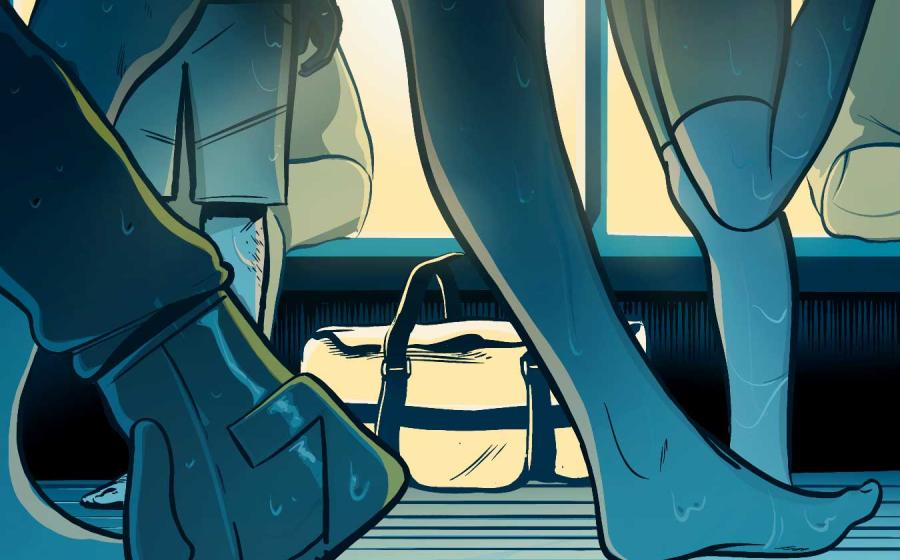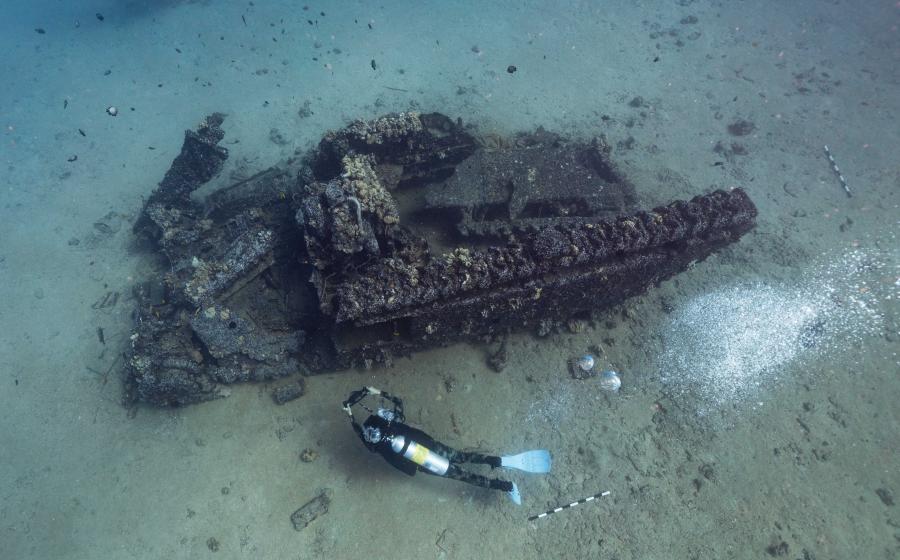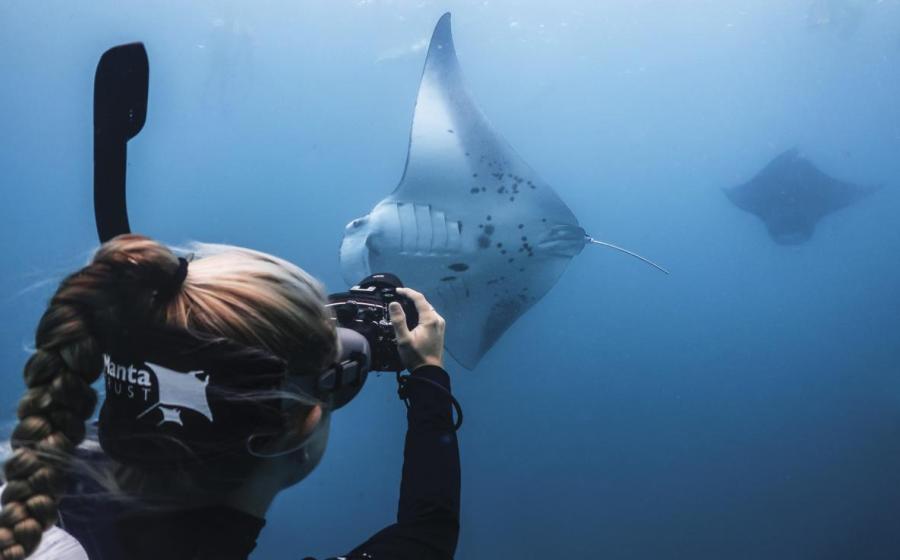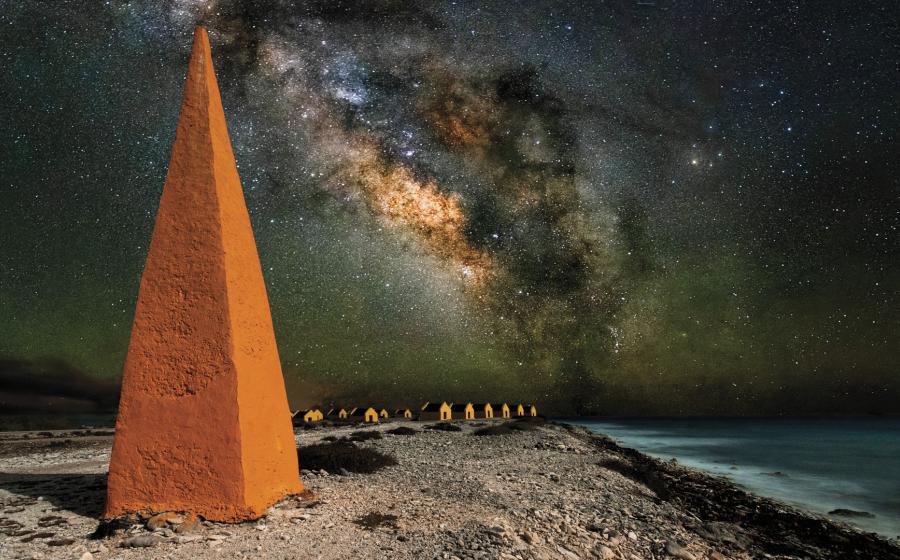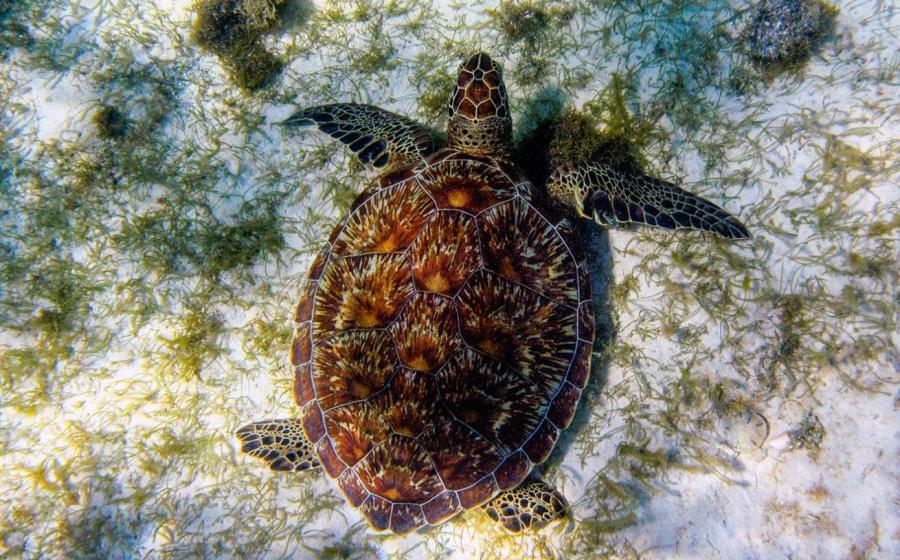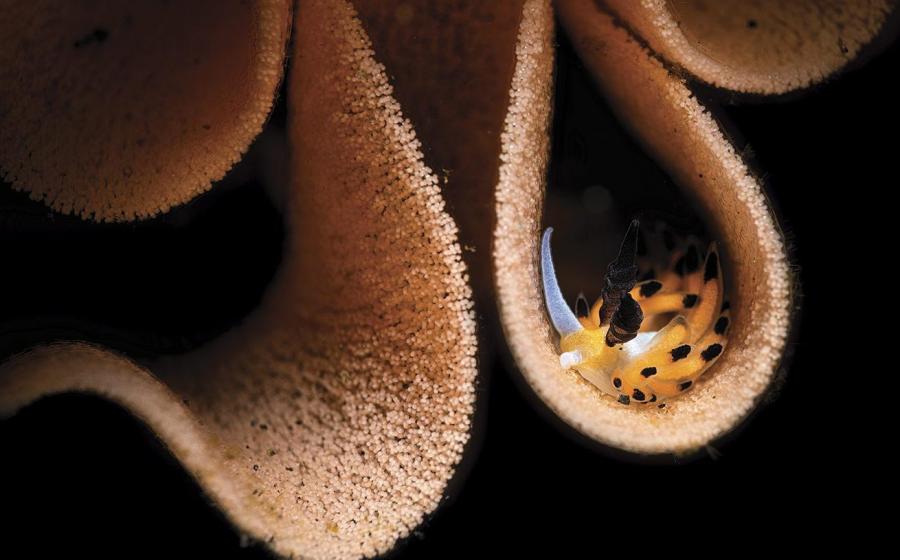Galapagos Aboard Peter Hughes' Sky Dancer, Feb. 3-10, 2002

Editor's note: During February 2002, Rodale's Scuba Diving's Director of Photography Stephen Frink escorted a group of 11 adults and three children to the Galapagos Islands aboard Peter Hughes' luxury live-aboard Sky Dancer. It was his intent to broadcast live to www.scubadiving.com from the Galapagos via a satellite phone with daily updates of words and pictures. But due to a software glitch in the satellite phone, technology defeated good intentions. However, Stephen recorded the event all the same, and we will simply time-shift the transmission by a week, allowing him time to get back home to a landline. Hey, if NBC could delay the live broadcasts from the Sydney Olympics, so can we.
Trip Preparation
Introduction to the Galapagos
The Galapagos Islands are a group of 13 major islands, six small islands and dozens of islets located in the Pacific Ocean some 1,000 km east of Ecuador. Only five of the islands are populated, with a total of just over 20,000 residents. Aside from a few small towns, the archipelago is blessedly remote and natural. The Galapagos are situated amid the confluence of four different oceanic currents, creating a marine environment of astonishing wealth and diversity.
Depending on where you may be in the islands, you can swim with schools of scalloped hammerhead sharks, enjoy up-close-and-personal encounters with a green sea turtle, lose yourself in a giant school of endemic brown-striped snapper, watch a squadron of eagle rays pass overhead, or view the comic antics of sea lions from under water at close vantage, or when the wide-angle universe bores you (not!) take macro photographs of a diverse world of bizarre macro critters. Whale sharks make consistent, if seasonal, appearances and even rare leviathans like the sperm whale are seen amid these waters.

How to Get There
The Galapagos are accessed via a two-hour flight from the Ecuadorian gateways of either Quito or Guayaquil, but once in the Galapagos, the live-aboard is the preferred means of exploration. Only the live-aboard dive boat can provide comfortable cruising from island to island and offer the extended range necessary to adequately sample the amazing dive diversity of these islands.
Highlights of a typical Galapagos cruise include visits to North Seymour (endemic garden eels, white tip reef sharks, and schools of yellow-tailed surgeonfish), Cousin's Rock (small creatures like large-banded blennies, nudibranchs and hawkfish, as well as moray eels and sea lions), Bartolome Island (Galapagos penguins), Wolf Island (consistent hammerhead action), Darwin Island (schools of barracuda, green sea turtles, steel pompano, African pompano, hammerheads and whale sharks), James Island (shore excursion for sea lions, Sally Lightfoot crabs and marine iguanas), Beagles (giant school of brown-striped snapper), Gordon Rocks (great pelagic action), and South Seymour Island (hundreds of nesting blue-footed boobies and frigate birds). The Galapagos remains one of the world's most pristine environments, providing a glimpse of unique and wondrous wildlife, above and below the surface.
Departure Taxes/Overweight
The departure tax is $20 per person, payable at your Ecuador exit gateway. The overweight issue, if it occurs, will happen leaving the Galapagos. TAME is the only airline serving the islands, and they can be a bit arbitrary in this regard. The official allowance is 20 kilos (44 pounds) per person, and for most diver/underwater photo types, overweight charges should be expected.

What to Bring
Passport for sure, but visa not necessary for U.S. citizens; sunblock (the Galapagos are on the equator and the sun is very intense); hat; sneakers or shoes you don't mind getting wet; knapsack; water bottle; cover-up for night or overcast days when it might be cool; bug repellent; binoculars; dry bag for cameras for shore excursions. Also, a dive light.
Scopolamine patches, Triptone or Dramamine are important for anyone prone to seasickness. While the sea conditions in the Central Islands are generally calm, most tours will have at least one open ocean crossing to the Northern Islands and back. Hopefully you will simply sleep through the 10- to 20-hour cruise (depending on which Central island), but be prepared should seasickness be a factor.
The Sky Dancer provides a safety sausage and dive alert, but if you have your own, bring these too. There are definitely currents on some dives, and even though the dinghy drivers are very good, it helps to make you easy to find in a choppy sea. Gloves are a good idea too as you might find yourself holding on to barnacle-encrusted rocks while doing your offgas time, not to mention the thermal advantages.
As far as film goes, bring lots! The topside excursions are very productive in terms of photography and can burn plenty of film. Even though we may only do three or four dives per day, the shore excursions make up for it. The first time I went to the Galapagos I did not bring enough film and found myself being too conservative with what I shot. So now I'll probably bring too much, but that's what works best for me. This is my first trip with my new Nikon D1X digital camera and Seacam housing, so theoretically shooting with digital for much of the underwater and most of the topside will reduce my normal film consumption. Of course that means a laptop, more media cards, CDs and miscellaneous computer accessories.

Thermal Protection
This is a hard one to answer for the Galapagos because the temperature changes so drastically between the islands according to the currents. For example, when I dived Roca Redondo in February 1993, the water was 68 degrees, and the same month 1994 it was 75 degrees. Up at Wolf and Darwin we had 82-degree water, and at Punta Vicente (aka "The Icebox") it was 60 degrees. Water temperature to a great extent depends on currents and upwelling, as does marine life concentration and species prevalence.
I've found that layering wetsuits is the best way to go. This year I brought a Henderson 2mm hooded vest with at least a 5mm one piece on the outside, with gloves and booties. But for Punta Vicente, I also packed a 7mm farmer john suit.
Photography Tips
The photography in the Galapagos is varied, both topside and underwater. For above water work I have found that multiple zooms covering 17 to 200mm works fine for most shots. For example, I'll probably bring a fixed 14mm, plus a 24-120 and 80-200mm zooms. On the last trip I had a chance to shoot a sperm whale tail at sunset and wished I had more than 200mm, but most things let you get fairly close in the Galapagos. 200mm should be long enough, but if you have room for something longer (such as an 80-400), and you have the room, by all means bring it along.

For film I still like Velvia for most macro and fish photography, but it may be a little slow for wide-angle in dark water and some topside conditions. The new Provia 100 is my current favorite 100 ISO film, but be absolutely, positively sure you are getting the new emulsion. It will have a magenta colored base (unprocessed) rather than the normal tan color, so make sure your camera store is giving you the right stuff! If the water turns green (a probability on some dives), you may prefer the cooler cast of Provia. Bring some 400 ISO film as well in case there are dusk or early morning photo-ops. Of course with the digital camera you can shift ISO per shot instead of only per roll.
-
Ana Maria Avila
-
Bob Brace
-
Ceci Cheung
-
Fred Fisher
-
Anne Fisher
-
Stephen Frink
-
Barbara Frink
-
Alexa Frink
-
Dennis Liberson
-
Tracy Liberson
-
Hanna Liberson
-
Alexa Liberson
-
Lisa Neumann
-
Erika Neumann
For underwater I'll bring a 15mm and 20mm for my Nikonos V cameras, and for the RS a 13mm, 20-35mm zoom and 50mm. I doubt I'll use the 13mm much though, as the super wide-angle opportunities are likely to be limited. The 15mm and 20mm should be good for turtles, sea lions, cownose rays, etc. The 50mm will be the hot set-up for a lot of the fish and macro critters (of course a 60mm in a housing will do the same). The housed 105mm is a powerful tool as well, especially with the skittish creatures like the red-lipped batfish of Punta Vicente. Adding a digital camera and housing to the mix either simplifies packing challenges, or makes them more complex due to film/pixel redundancy.Visibility is often excellent in the Northern Islands, maybe 80 to 100 feet. The Central Islands are typically not as good, and 20 to 60 feet is a more reasonable expectation. Currents and upwelling make the visibility continuously variable, but be prepared for more turbid water than you've encountered in some tropical destinations.
Tour Participants:
Trip Log
While the Galapagos are only a four-hour flight from Miami to Guayaquil or Quito, Ecuador, it is still kind of a tough first day of travel because you arrive late and depart for the islands early the next day. Peter Hughes Diving suggests an overnight in the Hilton in either Quito or Guayaquil, both of which are very comfortable and convenient. An hour-and-a-half flight aboard a TAME 727 brought us to the airport at Baltra, one of the Galapagos Islands. From there, with the assistance of Sky Dancer staff we picked up out bags and headed off to join our live-aboard.
First impressions of Sky Dancer are very reassuring: lovely lines, spacious and impressive. The dive deck is obviously well configured, as you would assume of a Peter Hughes vessel. There is a large, multitiered camera table, which we would quickly put to good use no doubt. The main salon is finished in hardwoods and tasteful upholstering. The cabins have en suite head and showers, individual AC units, and windows upstairs/portholes downstairs. Ample closet space and clever little hidden drawers beneath beds and tables to maximize storage options.
Day #1

The first day is really all about getting to the Galapagos, getting settled into the boat, and putting cameras and dive gear together. The Park does require a checkout dive, which is a good idea since most of us are wearing heavier wetsuits than normal. But truthfully, the Baltra checkout dive offers very little aesthetic stimulation. In fact, I passed on the dive myself and went snorkeling with my daughter and her friends instead, which changed a boring dive on a bunch of featureless rocks to a vicarious thrill as the kids saw their first sea lion in the water and a few booby birds on a rock. Mundane to world-travelers perhaps, but through the eyes of an eight-year old, a new world of wonder.
Day #2
The first real dive of this trip is at North Seymour. We are still getting our weights and cameras worked out, but the scenery was pretty impressive. Big schools of hammerheads cruise just beyond camera range (naturally), but the congregation of white tip sharks is far more accessible. Eagle rays were common along the reef slope, and large schools of yellowtailed surgeonfish grazed on algae clinging to the rock face. The water is cool, high 70s, but my Henderson 5mm and hooded vest was toasty warm. I wear one glove for protection from barnacles, but the other hand is free for camera manipulation and I don't feel chilled.
The Galapagos presents a wonderful opportunity for children to learn an appreciation for nature, and to that end my daughter Alexa, and her pals Alexa and Hanna Liberson, all kept journals of their memories during the week. I found it interesting to see these islands through their eyes as well as my own and will offer my daughter's "Dear Journal" observations along with my own.
Dear Journal,
Today I went snorkeling and Hanna, Alexa, and I saw booby birds, a lot of fish, and a bunch of sea urchins. It was so fun! We also saw a sea lion. He got like one foot away. The booby birds go poop on the rock a lot. We saw crabs, two black ones and two red ones. Bye for now, but not for long!

During the three-hour cruise to Cousins Rock from North Seymour we were treated to a magic dolphin encounter. A school of some 15 bottlenose dolphins began swimming along our bow wake, and then they got pretty aerobic ... jumping, twisting and generally doing what dolphins do so well, have fun. This was an amazing sight for the kids on board, but I must admit the adults were pretty stoked too.
Cousins Rock is a classic tuff cone island, with erosion sculpting an endless variety of ledges and undercuts, which in turn are home to an endless variety of fish and macro critters. The long-nosed hawkfish is common amid the black corals, and eagle rays, turtles, sea lions, and morays are common sights as well. There is a resident school of small barracuda here as well. This is a great place for photography, but I was plagued by little niggling problems. Like forgetting to attach my hot shoe synch inside the Seacam before I went under water. This meant the strobe didn't work and it wasn't like I could open it and fix it at 90 feet. But having my film cameras as backups kept me shooting on this dive, and a 30-second fix back at the camera table put the D1X back in action.
_Dear Journal,
Today we went snorkeling again. I saw a bunch of sea lions. I named a really nice sea lion Leo. He touched my hand. It was so cool! We saw a sea turtle and some white tip sharks. The sea lions got so close again! We saw a lot of colorful fish like a king angelfish. I saw some pufferfish too. One was really big. Bye journal. Oh yeah, I almost forgot. We also saw a lobster and a blue starfish and more sea urchins. Bye.
__Dear Journal,
It is the same day, February 4, 2002. We went snorkeling again. We saw fish, a blue starfish, sea lions, and sea urchins. The water was kind of foggy though. We saw a white tip shark, and I saw an eel and a parrotfish eating and pooping. And before we went snorkeling the second time we saw a lot of dolphins swimming and jumping in front of the bow of our boat. All the photographers got good shots. We saw a sea turtle while swimming. Bye.
__Dear Journal,
It is still the same day again, but we saw some more cool things. We saw penguins, and I saw one eating a fish. Then we went for a hike on a really big hill. When we got to the top we saw a beach with turtles. I saw one, and when I say we I mean my friends Alexa, Hanna and me. Bye journal.
_

As Alexa said, we anchored in the cove off Bartolome Island and had a nice encounter with the Galapagos penguins in residence there. While we saw them in the water, it was too turbid for quality underwater photos, but those sitting on the rocks were very tolerant of our approach. We shot some telephoto images from the dinghy, but some of the best shots were topside, with our housed digital cameras. We'd creep close to the rocks, wedge ourselves in against the surge, and shoot through our domes with 17-35mm Nikkor zooms. The penguins were totally indifferent to our presence in the water, but we would not be allowed to go on land to get this close. The housed camera made for a versatile tool here.
Day #3
We awake this morning to do a land walk on Rabida Island. Along an unusual reddish sand beach we have our first up-close-and-personal encounters with sea lions. The babies seem especially curious and they go up to the girls and sniff them. The photo opportunities are pretty powerful here, especially once the sun burns through the early morning haze.
Finally, to wrap a very busy day, we hiked to the top of Bartolome to shoot the sun setting over the bay. Even though there is a night dive for those so inclined, this is enough for me this day. The 400 steps combined with the day's frenetic pace made me sleep very well this night!
A note on the dive procedures: All diving is done from the 20-foot Zodiac dinghies. Air and nitrox are both available. Divers kit up on the dive deck with everything but their masks and fins. Then they step from the port side of the boat into the dinghy and motor off to the site. The boat rides are short, usually five minutes or less, and if the dive site is too distant from an anchorages the Sky Dancer stays live and in proximity. Very easy, safe and ergonomic indeed. Gratefully the dinghy drivers are very adept at keeping track of the diver's bubbles, and are always there for a quick retrieval.

We did our first dive of the morning along Rabida, and although visibility wasn't too great, there were naturally plenty of things to shoot. Actually I spent most of my time on a huge school of blackstriped salema in no more than 15 feet of water. I shot up my 512 MB card on the D1X, went into the shade of a coral head and deleted the bad ones, and went back to shoot some more. Very awesome tool.
After lunch we dived a vertical wall face along Albany Island. Once again visibility was poor, maybe only 25 feet, but since we knew that before jumping in, we all chose macro lenses on our digital cameras or film SLRs. I did well with a cooperative king angel, but the highlight of my dive, photographically and inspirationally, was a playful sea lion that briefly posed for my 105mm macro lens. Of course all I could do was shoot a tight head shot with the 105mm, but when those soulful eyes and cute little whiskers popped up in my LCD screen I knew I had a winner.
m

Already I can tell this is going to be a VERY full week. Between land walks like our afternoon visit to James Island (more sea lions and marine iguanas) and multiple dives daily we manage to have time to eat and maybe even relax a little--except for those of us who are shooting digital this week, for the post-dive computer tasks were time-consuming as well. We find we spend a massive amount of time downloading images, captioning, burning to CDs, and generally being tech-heads. Yes, in many ways digital is immediate and very exciting in terms of image capture, but in terms of post-shoot workflow, it is pretty tedious and labor-intensive. Not to mention a little antisocial.
Day #5
From Punta Vicente to the Northern Islands is only about an eight-hour crossing, and the calm seas and stability of Sky Dancer made it a pleasure. Actually I've been very impressed with this vessel all week. The crew is outstanding, the food is fine, the general dive safety procedures top-notch, and the dinghy drivers in particular are very attentive. The cabins are comfortable and the air fills right on every time. Perhaps the greatest compliment is that this trip is without aggravation. Thanks Peter. Thanks Ecoventura.
Day #6
Actually it was good to have a night without diving and a chance to offgas. While nothing is real deep here, it is certainly possible to spend lots of time in the 60- to 80-foot range and the body will definitely saturate. I dive nitrox on air tables whenever possible to build in some safety margin, but even my body told me it was on nitrogen overload and to back off a little. I truly appreciated the consistently high quality nitrox fills we got onboard. It helped me through the week for sure. (Note -- nitrox aboard costs $100 for the week, or can be purchased for $10 surcharge per tank).
Day #7
On this day we chose to dive Gordon Rocks, a place where I have had extremely productive dives in the past. Not so today really. The visibility was on the green/turbid side, but we did see four sea turtles the minute we dropped in the water. Then I worked a few eagle rays swimming in formation. And then when I took my eyes from the viewfinder, I saw I was amid the hammerheads. Of course, when they knew I knew they were there, they bolted. So, I was seeing some things, but not really capturing them on film/pixels. The current started to pick up too, and I began to have trouble moving against it. But I did see a huge aggregate of king angels feeding, something I had seen at Gordon Rocks before but never captured to my satisfaction. These fish absorb light, and to use a strong enough strobe and wide enough aperture to expose the fish sometimes makes the backgrounds too light. The immediate feedback from the LCD on the D1X made it possible for me to dial in the exposure, and then move in tight for the critical images.
In the days of film we'd be having film processed, looking at pictures together and generally interacting. Now, with digital we're shooting like we always did, except now there is the ability to edit under water and get the immediate feedback from the LCD. So, the percentage of keepers is higher and no one tends to run out of media while under water nearly as much. So, lots of images result. Now those images have to be cleared from the smart cards, put onto the hard drive, edited, ultimately burned to a CD, CD content confirmed, and then the smart card reformatted so we can go shoot again. And then for those so inclined, there is the whole different task of captioning and cataloging the saved images. The processing, captioning, and cataloging would happen with film too of course, but it would happen at home and not on the boat. Now, add to all this the discretionary refinements that can occur after importing to Adobe Photoshop. Cleaning up exposure, eliminating bits of backscatter, and correcting any other color or contrast concerns are additional time-suckers. The first thing you know there aren't enough hours in the day. Yet, such is the price of admission to the new paradigm. I know for the next trip I'll have a faster computer, more RAM, a better screen, and an internal CD or DVD burner. Maybe that, combined with a bit more experience, will make the post-shoot lifestyle more leisurely.
_Dear Journal,
Today we went snorkeling and saw lots of dolphins under water and two sea lions, and one of the sea lions did not have a back fin. The guide, Luis, said maybe a shark bit it off. Before that we went to an island and saw a lot of sea lions. There were two babies and they sniffed me. It tickled. I also saw marine iguanas. Then, this afternoon we saw whales from the boat. Then we went on a walk and saw a lot more sea lions. I got so close! We named a really cute baby sea lion Fussy Wuzzy. Bye journal.
_

Day #4
Dear Journal,
Today we saw whales! We also saw marine iguanas! We saw cool crabs and a lot of sea lion and fur seals. A baby sea lion touched me! Then we went snorkeling and saw two octopuses and a lot of cute sea lions. We also saw a parrotfish and a yellow-backed triggerfish. I also saw three more whales and a tortoise (really a turtle) too! Then we went snorkeling where the divers went and we saw five stingrays in really clear water, a couple of sea lions, a penguin, and a marine iguana. Daddy said he took a picture of a red-lipped batfish and I saw it on his digital camera. I take pictures with my digital camera too!
The morning begins with a land walk at Fernandina Island. This is Marine Iguana Metropolis, with large groups lying one atop the other to keep warm. There are plenty of sea lions as well, all vignettes of a gorgeous land and seascape. After a two-hour land visit, we all went snorkeling in a quiet bay. There were high hopes for finding a marine iguana under water, but we had to settle for shooting a particularly brazen specimen sitting atop a small rock outcropping.
The dives this day are in colder water than we have encountered so far. 68 degrees instead of 76 degrees elsewhere. At Tagus Cove the 105mm becomes the tool of choice due to turbid water conditions. I found a very cooperative octopus, as well as various blennies, hawkfish and other reef minutiae. At Punta Vicente the sand bottom at 100 feet is home to the elusive red-lipped batfish. Once we'd find one they would typically tolerate a couple of shots and then go into flight mode. Either they'd swim away or keep turning their face away from the lens. Very frustrating little fish, but pretty fascinating once captured on media. The challenge here is not to get so obsessed with the batfish that you ignore all the other very cool small creatures along the wall. But since the photo opportunities rise all the way to the surface, this is the perfect multilevel macro dive for either day or night.
_Dear Journal,
We went snorkeling in a place called the Icebox, but it wasn't so cold. I had a wetsuit and booties and gloves so I was warm. We saw sea lions and they went under the boat. We saw turtles, stingrays, and lots of fish. In fact, I saw six stingrays and I don't even know how many turtles, but I think I saw nine. We saw penguins, blue-footed boobies, and more. Bye Journal. Oh yeah ... we snorkeled into a cave too!
_

The northern islands, Wolf and Darwin, are the adventure dive mecca of the Galapagos. Possible encounters with whale sharks, schooling hammerheads, dolphins, Galapagos sharks, turtles, tuna, and so much more motivated us all to switch to wide-angle lenses. The visibility improved to about 80 feet up north, and the water oddly warmed as we moved farther from the equator. Of course this is a function of currents rather than latitude, but still, warm is warm.
On our first dive at Wolf we jumped in at a spot called Shark Bay, although this day it wasn't particularly sharky. There were moray eels scattered all along the bottom, and they willingly posed. I also shot guinea fowl pufferfish, several hawksbill turtles, yellowtailed surgeonfish, and bunches of barberfish seemingly grazing on triggerfish eggs. It was actually a great dive, but I only saw a couple of hammerheads and none came particularly close. Still, there was plenty to shoot and I recorded significant images to my card.
Our second dive was to another Wolf dive site known as Landslide. Here we did see Galapagos sharks and some hammerheads, but all fairly distant. The closest I got to any shark was maybe eight feet. Turtles yes. Sharks ... not really. However, I did get into an absolutely massive school of bonito near the surface. They raced all around me in such power and numbers I was once again reminded of how rich and deserving of protection these waters remain.
_Dear Journal,
Today we went snorkeling and saw lots of fish, sea turtles, dolphins and hammerhead sharks. We saw a kind of ray called a mobula ray. They were so cool. They were so close and very pretty. The water was so clear. It was beautiful! We saw frigate birds. They should be called big red balloon birds for the red thing on their necks. We saw baby dolphins too. Bye Journal.
_
Following our two morning dives at Wolf we steamed another couple of hours to Darwin Island. Normally the Sky Dancer spends two days of a one-week itinerary, but we asked for a custom cruise to optimize both land walks in the Central Islands and the diving in the north. There are no land walks possible at Wolf or Darwin, and I have found the terrestrial appeal of these islands to be nearly as compelling as the underwater.
Unfortunately, this day Darwin did not live up to its potential. Even though the seas were calm, and the water pleasantly warm and clear, the current was not running. Seemingly without current the hammerheads don't come close to the submerged rocks off Darwin's Arch. So, instead I shot a turtle and miscellaneous reef fish, but was unimpressed with the pelagic action this day. Apparently the rest of the guests felt the same, for by consensus we decided to head back to Wolf. Yeah ... I know. This can be one of the world's great dive sites, but for us this week it wasn't happening.
Darwin can be absolutely awesome, but it depends on season and currents. From June through December the water is cooler and rougher, and the skies more often overcast. But it also means hammerheads and whale sharks are far more prevalent at Darwin. Groups have seen as many as eight different whale sharks and hundreds of hammerheads on a single dive here,. But we purposely booked for February to assure calm seas and ample sunshine, but we didn't really have currents at either Wolf or Darwin. Probably due to the phase of the moon, which is yet something else to consider. Still, the Northern Islands in the fall sounds pretty exciting, and maybe next time we charter Sky Dancer will be for that season and those critters.
_Dear Journal,
We went snorkeling again. We saw hammerheads, silky sharks and an eel. The place we went was called Darwin. On the dinghy we saw dolphins. Bye Journal.
_

The first dive this morning was to The Pinnacle at Wolf Island. I've dived this site when the current was raging, and it can get a little hairy, but today the current was extremely mild. As soon as we dropped in we saw a marbled ray, and my wife Barbara moved in as an element of composition in my wide-angle shot. We also found a small cave to work diver silhouettes, and a cooperative eel to pose in the foreground. For us it was a very productive dive, but we never did make it all the way to the pinnacle. Those who did saw more schooling fish but no shark aggregates. The clock is ticking and I still don't have my hammerhead shot! Actually, we saw more sharks at Landslide than anywhere else so far, so that seemed the logical place to try again.
Between dives we went snorkeling with the kids. For me it was fun to hang out with the kids and watch them enjoy the sea. But, as my daughter was eager to point out, the best stuff happened after I went back to the mother ship to go diving.
Dear Journal,
Today we saw dolphins, hammerheads, fish and I saw a huge trumpetfish. There were baby dolphins too. The dolphins got REALLY CLOSE!!
On this final dive at Wolf I decided to quit being distracted by all the small animals and concentrate on hammerheads. But, after a few fly-bys and nothing really good enough to shoot, I did in fact find a cooperative green sea turtle and a few barracuda. There were thousands of spawning wrasse as well, and in fact the whole seafloor was alive with some small creature or another. But, still my target species, the scalloped hammerhead, remained elusive. So, with 500 psi in my tank and about three minutes before going into deco at 94 feet, I figured I'd wrap a few more frames on the barracuda. Luckily I drifted into some pretty hot hammerhead action at the last possible moment. One bold shark swam into view and I got three progressively closer shots with the D1X and 60mm lens with dome port. Seeing those images pop up on the LCD was a great satisfaction, and a relief knowing that I wouldn't get skunked by hammerheads this trip!
Now, 20 hours to steam back to the Central Islands, for our final dives tomorrow and a visit to the Charles Darwin Research Station.

Dear Journal,
Today is the last day. I am going to miss the Galapagos and Luis, our guide. He is really nice. The trip was really fun. The live-aboard boat was nice. And I will miss my friends Hanna and Alexa. Some of my favorites things were the baby dolphins, the sharks, the turtles, the sea lions, and the frigate birds. I liked the party that the crew had for us too. We all danced and had fun. Bye Journal.
Our final dive of this trip was to Plaza, actually more of a snorkel with the sea lions. Here it is very easy to get close, and you need to because the water isn't very clear. But, to remove myself from the photo challenges for a moment and just enjoy the moment, this was a very cool interlude. The mother sea lions got very close, and occasionally the big bull would swim through with a little bark to assert his authority. Our kids were really excited about this chance to swim with the sea lions, for while they had fleeting underwater encounters previously, they had never been really among them. With this wonderful memory, this year's dive experience in the Galapagos concludes.
The final afternoon we visit the Charles Darwin Research Station on Santa Cruz Island, which is kind of interesting the first time, but with multiple visits becomes a bit boring. It always struck me as "And now, a word from our sponsor". If you come to the Galapagos your tour company is obligated to take you to the Darwin Station. And since everyone must stop here at some point during the week, the city of Puerto Ayora has developed with T-shirt and curio shops to cater to the tourists. I must say however that most of the souvenirs are fairly tasteful. T-shirt vendors in Key West would certainly have a more crass way of exploiting the blue boobies.
As we stood on the dock on the last morning waiting for the bus to the airport I asked my wife to rate this trip. From the view of the quality of the services aboard the boat and the absolute friendliness of the crew, a 10. As far as the combination topside and underwater attractions of the Galapagos, a 10. From a child's perspective in terms of learning appreciation for nature, a 10 if not higher. As far as comparing this year's Galapagos encounters with those we've known in the past, very difficult to rate. The Galapagos experience will always depend on the currents, the time of year, moon phase, and luck. I've certainly seen more hammerheads, Galapagos sharks, and more schools of jack and tuna than I saw this time. But then I know that those who dive these islands when the waters are cooler have had multiple close encounters with all of the above. It is an ecosystem in constant motion, and when the currents and cold-water upwelling are there to bring nutrients to the surface, the diving is like nowhere else on earth. And for that which is there, it takes luck and skill to capture it photographically. Luck to be there, luck to see it, and the skill to freeze that very special moment in time.
MV Sky Dancer

The MV Sky Dancer specs are as follows:
-
Port of Registry: Ecuador
-
Built: Ecuador 2000
-
Construction: Steel
-
Type: Mono Hull
-
Length: 100 feet
-
Beam: 24 feet
-
Max. Passengers: 16
-
Staterooms: 8
-
Number of Crew: 8 seamen plus 2 National Park guides and 1 student guide
-
Number of Tenders: 1
-
Fuel Capacity: 8000 gallons
-
Freshwater Capacity: 6000 gallons
-
Desalination Production: 1500 gallons per day
-
Cruising Speed: 12 knots
-
Range: 2400 nautical miles
-
Navigation Aids: VHF, GMDSS, SSB, color radar, echo sounder, GPS, weather fax.
-
Compressor: (2) K-14 Bauer
-
Voltage: 110 volts and 220 volts
-
Air-conditioning: Yes
-
Length of Charters: 7- and 10-night itineraries
-
Dives Per Day: Up to 5
-
Photographic Services: E-6 processing, camera rental, photo instruction, video rental, video instruction.
Cabin amenities as follows:
LIDO DECK Master Staterooms (1,2,3,4)
One queen bed or two twin beds, private facilities, window view, mirrored cabinet, wardrobe, bathrobes, hair dryer, toiletries, fresh towels daily, independent air-conditioning and volume controls
DOLPHIN DECK Twin Staterooms (5,6,7,8)
Two twin beds, private facilities, portlight view, mirrored cabinet, wardrobe, bathrobes, hair dryer, toiletries, fresh towels daily, independent air-conditioning and volume controls
Dive Tenders
The M/V Sky Dancer features two MK V Zodiac brand inflatable dive tenders of 6.5 meters in length (21.5 feet) and 2.5 meters in width with 40 hp 4-stroke engines for maximum efficiency and a smooth, quiet, low exhaust ride.
Each tender accommodates up to eight guests on each, plus a driver. Each tender will also carry two divemasters on board: One is a naturalist guide (and a qualified divemaster) and the other is a dive professional approved by the National Park. One guide will assist with shooting video or photos. On land tours a guide will even carry a sun reflector to assist guests with taking well-lit photos of land fauna without the use of a strobe (which is prohibited by the Marine Park).
Dive Sites

The following is directly verbatim from Fernando Ortiz, one of the most experienced dive guides in the Galapagos Islands:
-
Currents: none, sometimes, water motion associated to tides.
-
Water temp: Dec. - April: 74 - 78 / May - Nov: 68 - 72 degrees Fahrenheit
-
Thermoclines: none
North Seymour
Great dive site. Good for all sorts of rays year-round and especially good for mantas from December until April. Lots of whitetip reef sharks rest on the sandy spots. Good place for sea lions, sea turtles and hammerhead sharks. Several thick schools of grunts and snappers live associated to the reef.
-
Currents: prevalently from south. It goes from moderate to very strong.
-
Water temp: Dec. - April: 74 - 78 / May - Nov: 68 - 72 degrees Fahrenheit
-
Thermoclines: at 45 ft and sometimes also at 75 ft.
-
Currents: prevalently from northeast. It goes from moderate to strong. Occasionally very strong, coming from the north.
-
Water temp: Dec. - April: 74 --78 / May -- Nov: 65 -- 72 degrees Fahrenheit
-
Thermoclines: variable from 65 to 90 ft
Tagus Cove
Cold-water dive (sometimes as low as 62F.). It is excellent for sea turtles and macro subjects such as red-lipped batfish, and the endemic "camotillo," a species of fish restricted only to Galapagos waters. While making your safety stop, keep an eye out for penguins or flightless cormorants coming your way. On the deep sandy bottom you can find sawfish and devil rays.
-
Currents: none.
-
Water temp: Dec. - April: 70 - 76 / May - Nov: 62 - 72 degrees Fahrenheit
-
Thermoclines: variable, but normally below 65 ft
-
Currents: none
-
Water temp: Dec. - April: 70 - 76 / May - Nov: 62 - 72 degrees Fahrenheit
-
Thermoclines: variable, but normally below 65 ft
Wolf Island
One of those magical islands, with several dive sites to choose from. If you want to see sharks, you are at the right spot. This is a place for schooling hammerhead sharks, large aggregations of Galapagos sharks and occasionally whale sharks. Seeing dolphins, large schools of tuna, spotted eagle rays, barracudas, sea lions and sea turtles is common. The bottom is littered with hundreds of moray eels, many of them free-swimming. Being several degrees warmer than the Central Islands, you can look for many representatives of Indopacific underwater fauna.
-
Currents: Normally from southeast, but variable. It goes from moderate to very strong. Eddies and down drafts associated to some dive sites. The south side of the island features strong surge that is potentially dangerous if divers don't surface out in deep waters. Trust your guide and do as he recommends.
-
Water temp: Dec. - April: 76--82 / May -- Nov: 74 -- 76 degrees Fahrenheit
-
Thermoclines: at around 65 ft, but highly variable
-
Currents: Normally from southeast, but variable. It goes from moderate to very strong. Current splits right in front of The Arch. Drifting south-southeast is potentially dangerous due to shallow reefs and the difficulty to cover that area for search. Trust your guide and do as he recommends.
-
Water temp: Dec. - April: 76 - 82 / May - Nov: 72 - 78 degrees Fahrenheit
-
Thermoclines: at around 65 ft but variable.
The Northern Channel
On the south side of Seymour Island and no deeper than 50 feet deep, the northern channel is superb. It features an enormous "field" of garden eels, stingrays, a school of spotted eagle rays, whitetip reef sharks and thick schools of grunts, snappers and goatfish. When Dr. Sylvia Earle described Galapagos as "the fishiest place in the world", she had probably dived this site.
-
Currents: from east. It goes from moderate to strong. When surfacing, water accelerates on top of the shallow part of the reef causing quick drifts. Make your safety stop holding to a rock.
-
Water temp: Dec. - April: 74 - 78 / May - Nov: 68 - 72 degrees Fahrenheit
-
Thermoclines: at about 45 ft.
-
Currents: none, sometimes, water motion associated with tides.
-
Water temp: Dec. - April: 74 - 78 / May - Nov: 68 - 72 degrees Fahrenheit
-
Thermoclines: none
Gardner's Seamount
This place features the greatest biodiversity in the archipelago. During a dive here, you can see anything from the smallest barnacle blenny to whale sharks. Common inhabitants of this seamount are large schools of yellow and dog snappers, Mexican goatfish, moray eels, stingrays, spotted eagle rays, whitetip reef sharks, Pacific burrfish, guineafowl puffers, bullseye puffers, box fishes, king angelfish, three banded butterflyfish, barber fish and three species of grunts. If you venture to the sandy bottom, you may find red-lipped batfish.
-
Currents: normally from southeast. Variable, but mostly moderate.
-
Water temp: Dec. - April: 74 - 78 / May - Nov: 68 - 72 degrees Fahrenheit
-
Thermoclines: at around 45 ft.
-
Currents: normally from southeast. Variable, but mostly moderate.
-
Water temp: Dec. - April: 74 - 78 / May - Nov: 68 - 72 degrees Fahrenheit
-
Thermoclines: at around 45 ft.
Champion Island
One of the nicest real drift wall dives in Galapagos. You can easily glide alongside the island escorted by a group of friendly sea lions. You can also look around for sharks, rays and sea turtles. If you are interested in small creatures, look for seahorses, longnose hawkfish and coral hawkfish.
-
Currents: normally from southeast. Variable, but mostly moderate.
-
Water temp: Dec. - April: 74 - 78 / May - Nov: 68 - 72 degrees Fahrenheit
-
Thermoclines: at around 45 ft.
-
Currents: normally from southeast. Variable from moderate to very strong.
-
Water temp: Dec. - April: 74 - 78 / May - Nov: 68 - 72 degrees Fahrenheit
-
Thermoclines: none
-
Currents: Variable in both direction and strength. Very strong surge. Unpredictable downcurrent.
-
Water temp: Dec. - April: 74 - 78 / May - Nov: 68 - 72 degrees Fahrenheit
-
Thermoclines: normally below 45 ft.
Gordon's Rocks
An exciting dive. Manta rays, spotted eagle rays, Galapagos sharks and hammerheads are common sightings. Its unique underwater topography allows forever changing conditions in terms of currents and surge. You can find sea turtles and seasonally, a large school of up to 50 cownose or golden eagle rays.
-
Currents: from southeast. Variable from moderate to very strong. Due to the peculiar underwater topography, there is the presence of eddies and downcurrents. Surge can be magnified inside the caldera of this very eroded underwater crater.
-
Water temp: Dec. - April: 74 - 78 / May - Nov: 68 - 72 degrees Fahrenheit
-
Thermoclines: normally below 65 ft.
-
Currents: normally from the southeast. Variable from moderate to very strong.
-
Water temp: Dec. - April: 74 - 78 / May - Nov: 68 - 72 degrees Fahrenheit
-
Thermoclines: normally below 45 ft.
Isla Lobos
20 ft of water, scores of friendly sea lions come to join the divers. It is good for garden eels, some tropical fish and stingrays. Sea turtles and eagle rays are found frequently. A couple of times, we have seen marine iguanas grazing under water.

Cousins Rock
A dive site with a bit of everything for every taste. You can find whitetip reef sharks, hammerhead sharks, sea lions hunting, fur seals and many sleeping sea turtles. A highlight is a resident school of up to 30 spotted eagle rays. If you are interested in macro photography, look for seahorses, frogfish, lobster, arrow crabs, cup coral, blue crabs, longnose hawkfish, coral hawkfish, nudibranchs, etc. It is superb for night or day diving.

Punta Vicente Roca
One of the very best macro dives in Galapagos. It can be cold (as low as 62F). The list of invertebrates that is found on this wall dive is endless, from the simplest sponge to really beautiful flatworms. Besides you can find seahorses, frogfish, port Jackson sharks, red-lipped batfish, and the endemic "camotillo". At the beginning of the dive keep your eyes open for "mola mola" or moon fish.

Darwin Island
Considered by many experienced divers as the best dive site in the world, The Arch at Darwin island honors its reputation. It is warmer by a few degrees than the Central Islands. In a single dive you can find schooling hammerhead sharks, Galapagos sharks, large pods of dolphins, thick schools of skipjack and yellowfin tuna, big eye jacks, mobula rays and silky sharks. From June to November, we can almost guarantee whale sharks in numbers of up to eight different individuals in one single dive. The presence of occasional tiger sharks, black and blue marlin and killer whales, complements this amazing diving experience. If you still have time to look for smaller stuff, you'll find octopus, flounders and an enormous variety and abundance of tropical fish. Darwin Island is the biggest jewel on the Galapagos Crown.

North Plaza
In our normal itineraries, this dive site is the best way of ending your trip on board Sky Dancer. Its shallow waters are home to a rookery of playful young sea lions.

Enderby Island
A great dive site. If you stay above 50 ft, you can see thick schools of king angelfish; yellow tailed surgeonfish, puffers, grunts, snappers and groupers. It is also a good place for hammerheads and Galapagos sharks. At the end of the dive, on the wall, you can find seahorses clinging to the branches of the black coral.

Devils Crown
A shallow dive site that features thick schools of all kinds of tropical fish. Groupers, snappers, grunts, creolefish, rays, sharks, morays, jacks, sea lions and turtles mingle together in a chaotic frenzy of sea life. Hold on to a rock and enjoy the show.
Other Dive Sites
Roca Redonda
The word unpredictable may have been specifically created to describe this dive site. It is the peak of an enormous underwater mountain. It is famous for its Galapagos sharks, schooling hammerheads, and large schools of barracudas and underwater fumaroles. It is also famous for its overpowering down draft and surge, and its dramatic and sudden fog. It is not a place for beginners.

Cabo Marshall
A good dive site. Hammerheads and mantas are a common sight. Chevron barracuda, snappers, groupers and occasionally thick schools of the endemic brown-striped salema are part of the resident underwater fauna. The infrequent presence of oceanic white tipped sharks, blue and black marlin make this a dive with lots of potential surprises.

Editor's note: During February 2002, Rodale's Scuba Diving's Director of Photography Stephen Frink escorted a group of 11 adults and three children to the Galapagos Islands aboard Peter Hughes' luxury live-aboard Sky Dancer. It was his intent to broadcast live to www.scubadiving.com from the Galapagos via a satellite phone with daily updates of words and pictures. But due to a software glitch in the satellite phone, technology defeated good intentions. However, Stephen recorded the event all the same, and we will simply time-shift the transmission by a week, allowing him time to get back home to a landline. Hey, if NBC could delay the live broadcasts from the Sydney Olympics, so can we.
Trip Preparation
Introduction to the Galapagos
The Galapagos Islands are a group of 13 major islands, six small islands and dozens of islets located in the Pacific Ocean some 1,000 km east of Ecuador. Only five of the islands are populated, with a total of just over 20,000 residents. Aside from a few small towns, the archipelago is blessedly remote and natural. The Galapagos are situated amid the confluence of four different oceanic currents, creating a marine environment of astonishing wealth and diversity.
Depending on where you may be in the islands, you can swim with schools of scalloped hammerhead sharks, enjoy up-close-and-personal encounters with a green sea turtle, lose yourself in a giant school of endemic brown-striped snapper, watch a squadron of eagle rays pass overhead, or view the comic antics of sea lions from under water at close vantage, or when the wide-angle universe bores you (not!) take macro photographs of a diverse world of bizarre macro critters. Whale sharks make consistent, if seasonal, appearances and even rare leviathans like the sperm whale are seen amid these waters.
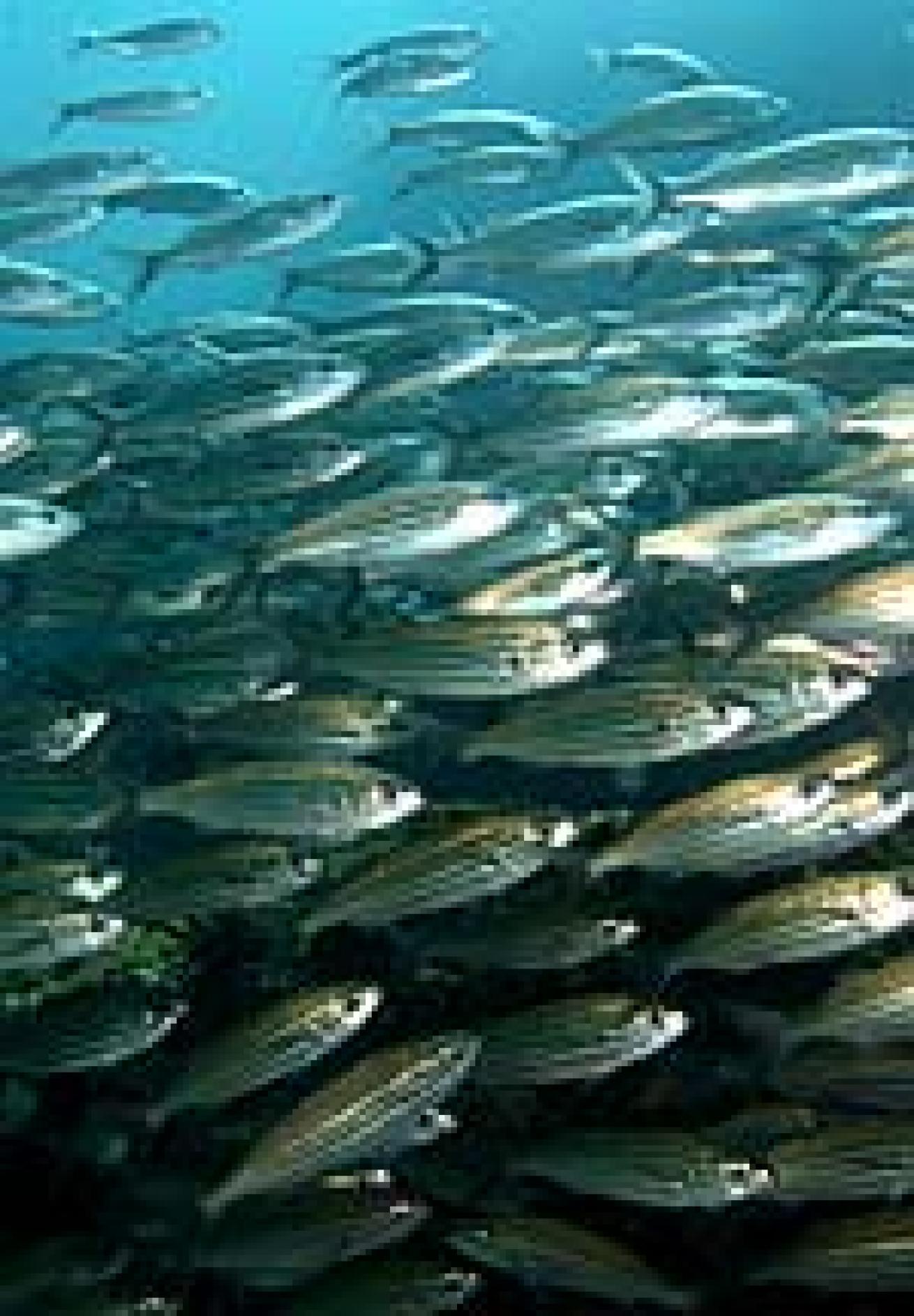
How to Get There
The Galapagos are accessed via a two-hour flight from the Ecuadorian gateways of either Quito or Guayaquil, but once in the Galapagos, the live-aboard is the preferred means of exploration. Only the live-aboard dive boat can provide comfortable cruising from island to island and offer the extended range necessary to adequately sample the amazing dive diversity of these islands.
Highlights of a typical Galapagos cruise include visits to North Seymour (endemic garden eels, white tip reef sharks, and schools of yellow-tailed surgeonfish), Cousin's Rock (small creatures like large-banded blennies, nudibranchs and hawkfish, as well as moray eels and sea lions), Bartolome Island (Galapagos penguins), Wolf Island (consistent hammerhead action), Darwin Island (schools of barracuda, green sea turtles, steel pompano, African pompano, hammerheads and whale sharks), James Island (shore excursion for sea lions, Sally Lightfoot crabs and marine iguanas), Beagles (giant school of brown-striped snapper), Gordon Rocks (great pelagic action), and South Seymour Island (hundreds of nesting blue-footed boobies and frigate birds). The Galapagos remains one of the world's most pristine environments, providing a glimpse of unique and wondrous wildlife, above and below the surface.
Departure Taxes/Overweight
The departure tax is $20 per person, payable at your Ecuador exit gateway. The overweight issue, if it occurs, will happen leaving the Galapagos. TAME is the only airline serving the islands, and they can be a bit arbitrary in this regard. The official allowance is 20 kilos (44 pounds) per person, and for most diver/underwater photo types, overweight charges should be expected.
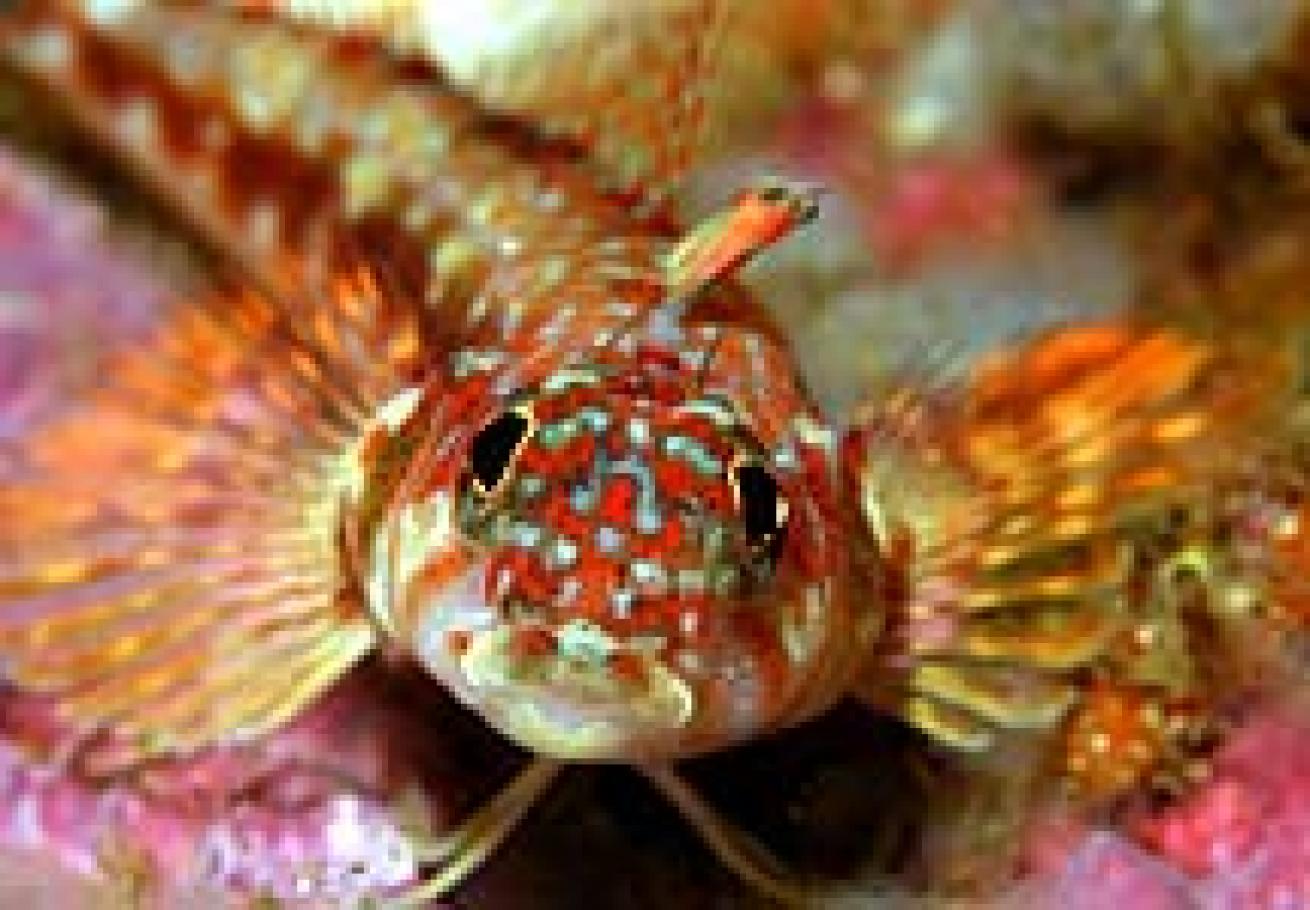
What to Bring
Passport for sure, but visa not necessary for U.S. citizens; sunblock (the Galapagos are on the equator and the sun is very intense); hat; sneakers or shoes you don't mind getting wet; knapsack; water bottle; cover-up for night or overcast days when it might be cool; bug repellent; binoculars; dry bag for cameras for shore excursions. Also, a dive light.
Scopolamine patches, Triptone or Dramamine are important for anyone prone to seasickness. While the sea conditions in the Central Islands are generally calm, most tours will have at least one open ocean crossing to the Northern Islands and back. Hopefully you will simply sleep through the 10- to 20-hour cruise (depending on which Central island), but be prepared should seasickness be a factor.
The Sky Dancer provides a safety sausage and dive alert, but if you have your own, bring these too. There are definitely currents on some dives, and even though the dinghy drivers are very good, it helps to make you easy to find in a choppy sea. Gloves are a good idea too as you might find yourself holding on to barnacle-encrusted rocks while doing your offgas time, not to mention the thermal advantages.
As far as film goes, bring lots! The topside excursions are very productive in terms of photography and can burn plenty of film. Even though we may only do three or four dives per day, the shore excursions make up for it. The first time I went to the Galapagos I did not bring enough film and found myself being too conservative with what I shot. So now I'll probably bring too much, but that's what works best for me. This is my first trip with my new Nikon D1X digital camera and Seacam housing, so theoretically shooting with digital for much of the underwater and most of the topside will reduce my normal film consumption. Of course that means a laptop, more media cards, CDs and miscellaneous computer accessories.
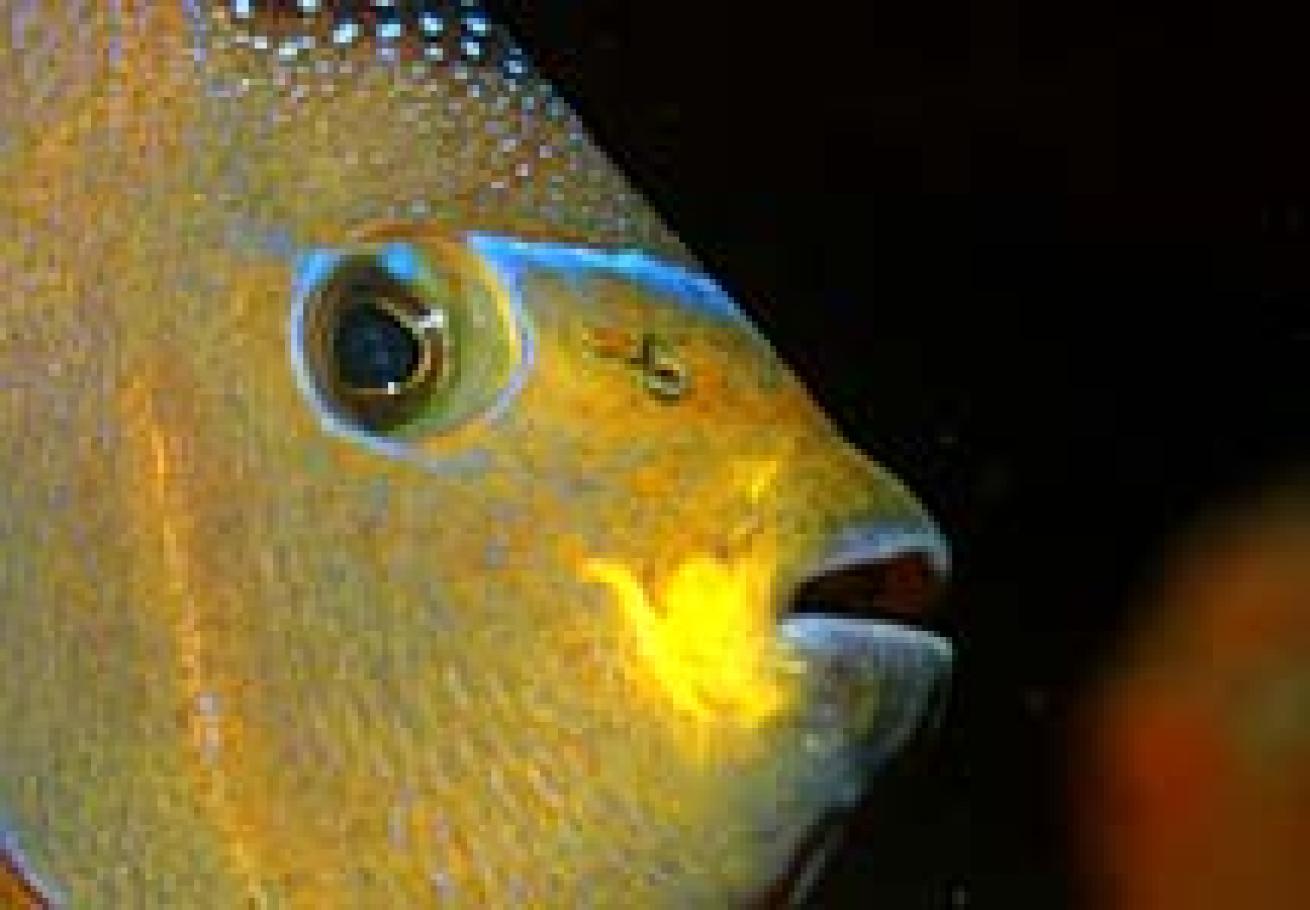
Thermal Protection
This is a hard one to answer for the Galapagos because the temperature changes so drastically between the islands according to the currents. For example, when I dived Roca Redondo in February 1993, the water was 68 degrees, and the same month 1994 it was 75 degrees. Up at Wolf and Darwin we had 82-degree water, and at Punta Vicente (aka "The Icebox") it was 60 degrees. Water temperature to a great extent depends on currents and upwelling, as does marine life concentration and species prevalence.
I've found that layering wetsuits is the best way to go. This year I brought a Henderson 2mm hooded vest with at least a 5mm one piece on the outside, with gloves and booties. But for Punta Vicente, I also packed a 7mm farmer john suit.
Photography Tips
The photography in the Galapagos is varied, both topside and underwater. For above water work I have found that multiple zooms covering 17 to 200mm works fine for most shots. For example, I'll probably bring a fixed 14mm, plus a 24-120 and 80-200mm zooms. On the last trip I had a chance to shoot a sperm whale tail at sunset and wished I had more than 200mm, but most things let you get fairly close in the Galapagos. 200mm should be long enough, but if you have room for something longer (such as an 80-400), and you have the room, by all means bring it along.
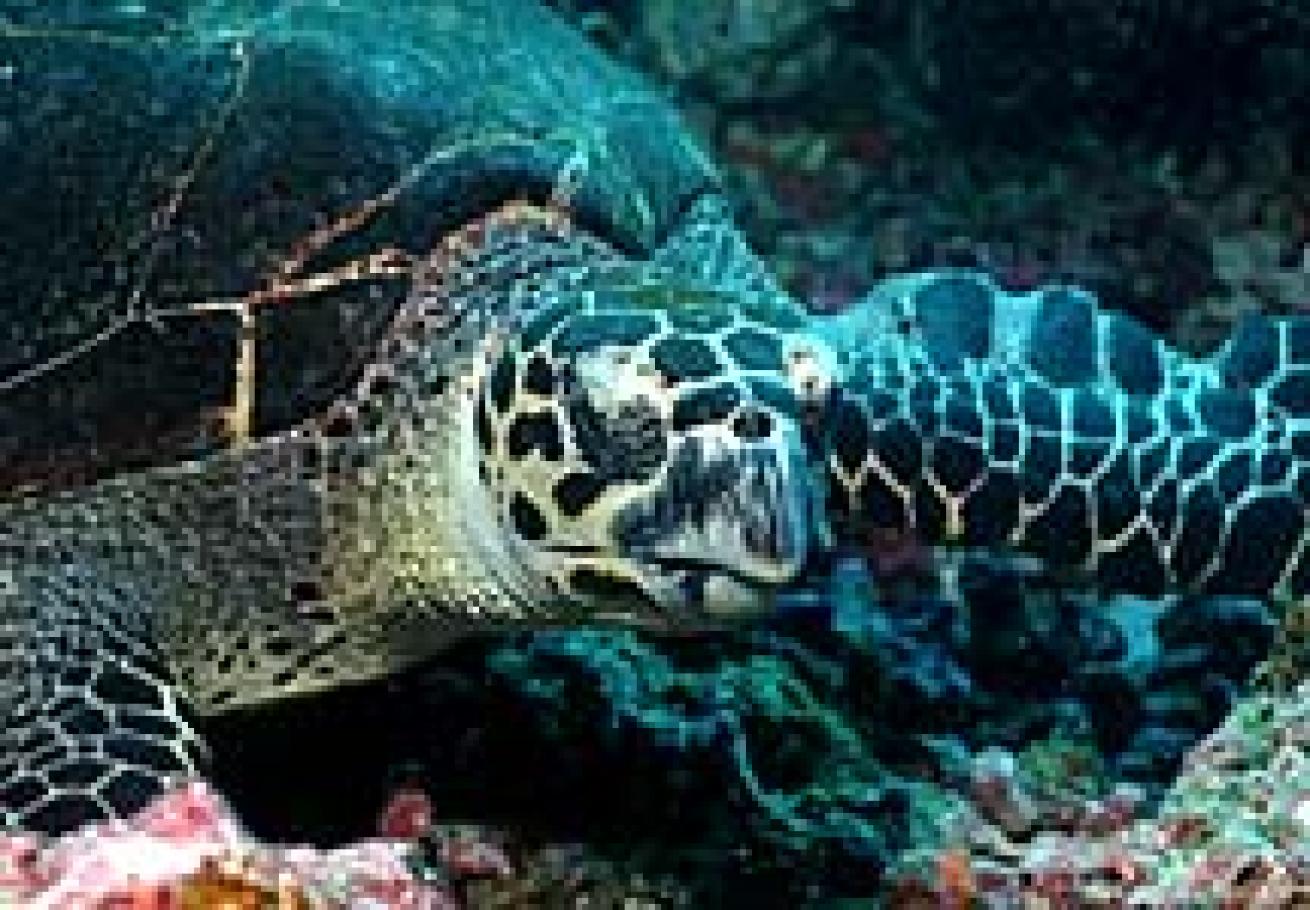
For film I still like Velvia for most macro and fish photography, but it may be a little slow for wide-angle in dark water and some topside conditions. The new Provia 100 is my current favorite 100 ISO film, but be absolutely, positively sure you are getting the new emulsion. It will have a magenta colored base (unprocessed) rather than the normal tan color, so make sure your camera store is giving you the right stuff! If the water turns green (a probability on some dives), you may prefer the cooler cast of Provia. Bring some 400 ISO film as well in case there are dusk or early morning photo-ops. Of course with the digital camera you can shift ISO per shot instead of only per roll.
For underwater I'll bring a 15mm and 20mm for my Nikonos V cameras, and for the RS a 13mm, 20-35mm zoom and 50mm. I doubt I'll use the 13mm much though, as the super wide-angle opportunities are likely to be limited. The 15mm and 20mm should be good for turtles, sea lions, cownose rays, etc. The 50mm will be the hot set-up for a lot of the fish and macro critters (of course a 60mm in a housing will do the same). The housed 105mm is a powerful tool as well, especially with the skittish creatures like the red-lipped batfish of Punta Vicente. Adding a digital camera and housing to the mix either simplifies packing challenges, or makes them more complex due to film/pixel redundancy.Visibility is often excellent in the Northern Islands, maybe 80 to 100 feet. The Central Islands are typically not as good, and 20 to 60 feet is a more reasonable expectation. Currents and upwelling make the visibility continuously variable, but be prepared for more turbid water than you've encountered in some tropical destinations.
Tour Participants:
Ana Maria Avila
Bob Brace
Ceci Cheung
Fred Fisher
Anne Fisher
Stephen Frink
Barbara Frink
Alexa Frink
Dennis Liberson
Tracy Liberson
Hanna Liberson
Alexa Liberson
Lisa Neumann
Erika Neumann
Trip Log
While the Galapagos are only a four-hour flight from Miami to Guayaquil or Quito, Ecuador, it is still kind of a tough first day of travel because you arrive late and depart for the islands early the next day. Peter Hughes Diving suggests an overnight in the Hilton in either Quito or Guayaquil, both of which are very comfortable and convenient. An hour-and-a-half flight aboard a TAME 727 brought us to the airport at Baltra, one of the Galapagos Islands. From there, with the assistance of Sky Dancer staff we picked up out bags and headed off to join our live-aboard.
First impressions of Sky Dancer are very reassuring: lovely lines, spacious and impressive. The dive deck is obviously well configured, as you would assume of a Peter Hughes vessel. There is a large, multitiered camera table, which we would quickly put to good use no doubt. The main salon is finished in hardwoods and tasteful upholstering. The cabins have en suite head and showers, individual AC units, and windows upstairs/portholes downstairs. Ample closet space and clever little hidden drawers beneath beds and tables to maximize storage options.
Day #1
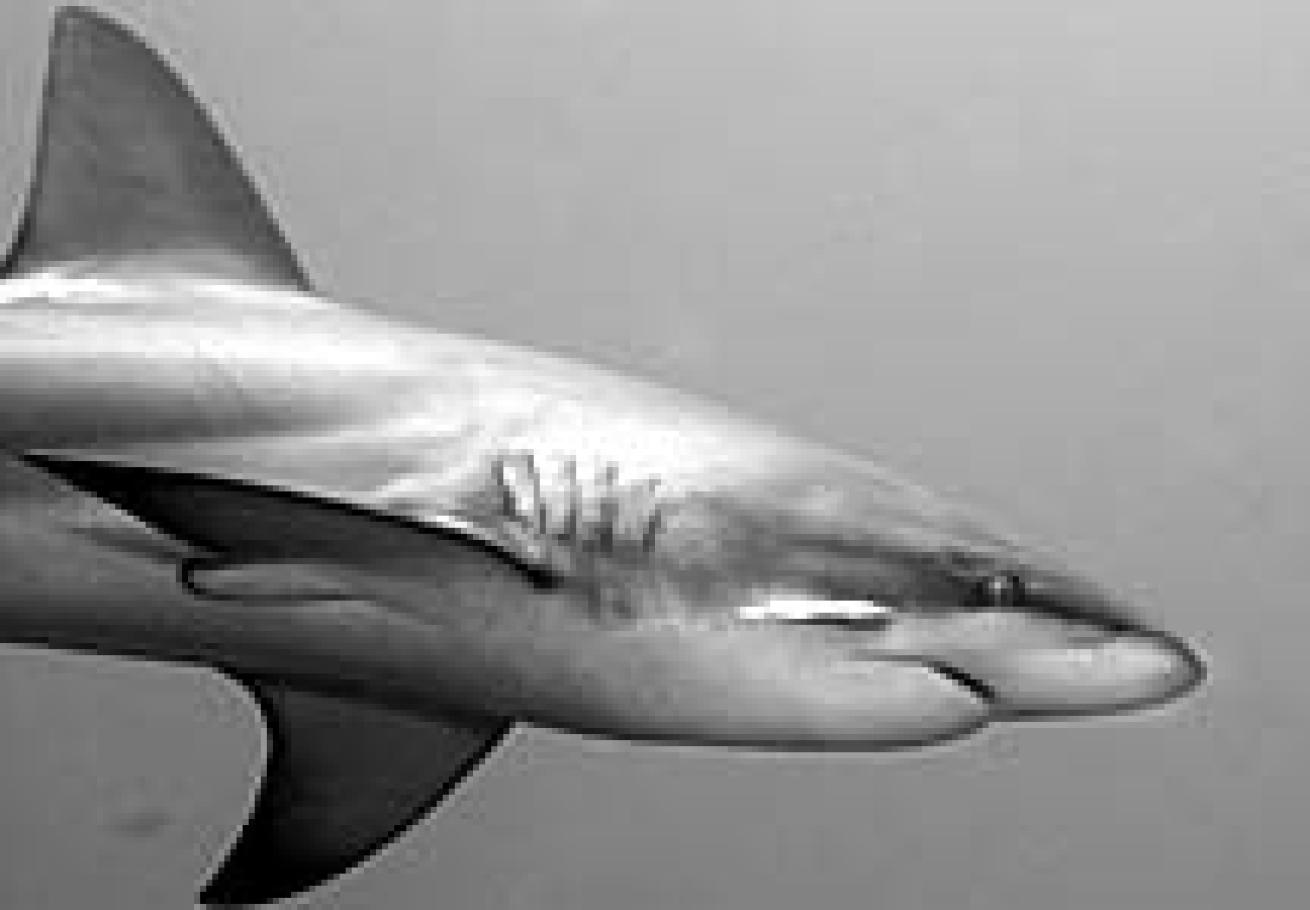
The first day is really all about getting to the Galapagos, getting settled into the boat, and putting cameras and dive gear together. The Park does require a checkout dive, which is a good idea since most of us are wearing heavier wetsuits than normal. But truthfully, the Baltra checkout dive offers very little aesthetic stimulation. In fact, I passed on the dive myself and went snorkeling with my daughter and her friends instead, which changed a boring dive on a bunch of featureless rocks to a vicarious thrill as the kids saw their first sea lion in the water and a few booby birds on a rock. Mundane to world-travelers perhaps, but through the eyes of an eight-year old, a new world of wonder.
The Galapagos presents a wonderful opportunity for children to learn an appreciation for nature, and to that end my daughter Alexa, and her pals Alexa and Hanna Liberson, all kept journals of their memories during the week. I found it interesting to see these islands through their eyes as well as my own and will offer my daughter's "Dear Journal" observations along with my own.
Dear Journal,
Today I went snorkeling and Hanna, Alexa, and I saw booby birds, a lot of fish, and a bunch of sea urchins. It was so fun! We also saw a sea lion. He got like one foot away. The booby birds go poop on the rock a lot. We saw crabs, two black ones and two red ones. Bye for now, but not for long!
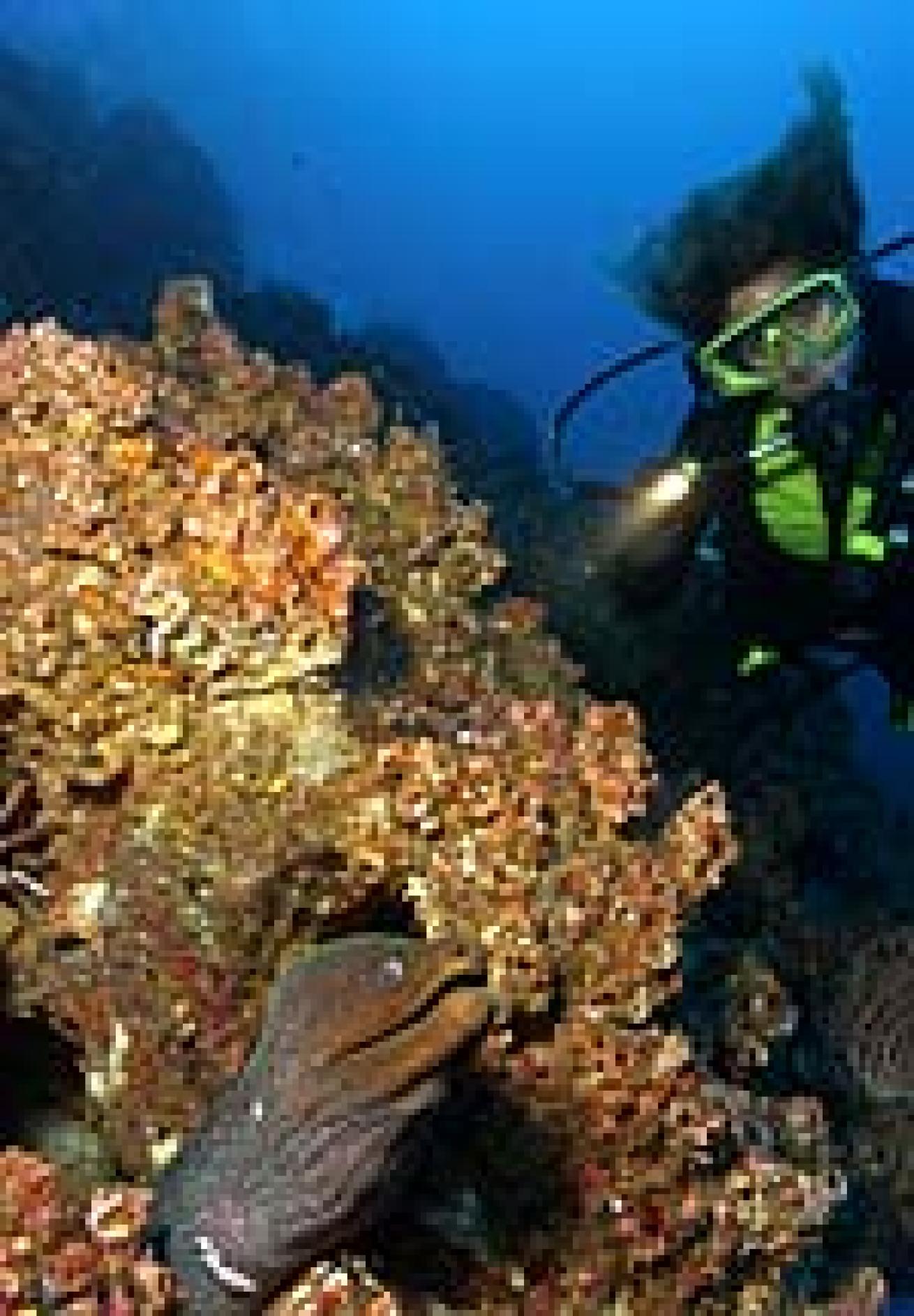
Day #2
The first real dive of this trip is at North Seymour. We are still getting our weights and cameras worked out, but the scenery was pretty impressive. Big schools of hammerheads cruise just beyond camera range (naturally), but the congregation of white tip sharks is far more accessible. Eagle rays were common along the reef slope, and large schools of yellowtailed surgeonfish grazed on algae clinging to the rock face. The water is cool, high 70s, but my Henderson 5mm and hooded vest was toasty warm. I wear one glove for protection from barnacles, but the other hand is free for camera manipulation and I don't feel chilled.
During the three-hour cruise to Cousins Rock from North Seymour we were treated to a magic dolphin encounter. A school of some 15 bottlenose dolphins began swimming along our bow wake, and then they got pretty aerobic ... jumping, twisting and generally doing what dolphins do so well, have fun. This was an amazing sight for the kids on board, but I must admit the adults were pretty stoked too.
Cousins Rock is a classic tuff cone island, with erosion sculpting an endless variety of ledges and undercuts, which in turn are home to an endless variety of fish and macro critters. The long-nosed hawkfish is common amid the black corals, and eagle rays, turtles, sea lions, and morays are common sights as well. There is a resident school of small barracuda here as well. This is a great place for photography, but I was plagued by little niggling problems. Like forgetting to attach my hot shoe synch inside the Seacam before I went under water. This meant the strobe didn't work and it wasn't like I could open it and fix it at 90 feet. But having my film cameras as backups kept me shooting on this dive, and a 30-second fix back at the camera table put the D1X back in action.
_Dear Journal,
Today we went snorkeling again. I saw a bunch of sea lions. I named a really nice sea lion Leo. He touched my hand. It was so cool! We saw a sea turtle and some white tip sharks. The sea lions got so close again! We saw a lot of colorful fish like a king angelfish. I saw some pufferfish too. One was really big. Bye journal. Oh yeah, I almost forgot. We also saw a lobster and a blue starfish and more sea urchins. Bye.
_
_Dear Journal,
It is the same day, February 4, 2002. We went snorkeling again. We saw fish, a blue starfish, sea lions, and sea urchins. The water was kind of foggy though. We saw a white tip shark, and I saw an eel and a parrotfish eating and pooping. And before we went snorkeling the second time we saw a lot of dolphins swimming and jumping in front of the bow of our boat. All the photographers got good shots. We saw a sea turtle while swimming. Bye.
_
_Dear Journal,
It is still the same day again, but we saw some more cool things. We saw penguins, and I saw one eating a fish. Then we went for a hike on a really big hill. When we got to the top we saw a beach with turtles. I saw one, and when I say we I mean my friends Alexa, Hanna and me. Bye journal.
_
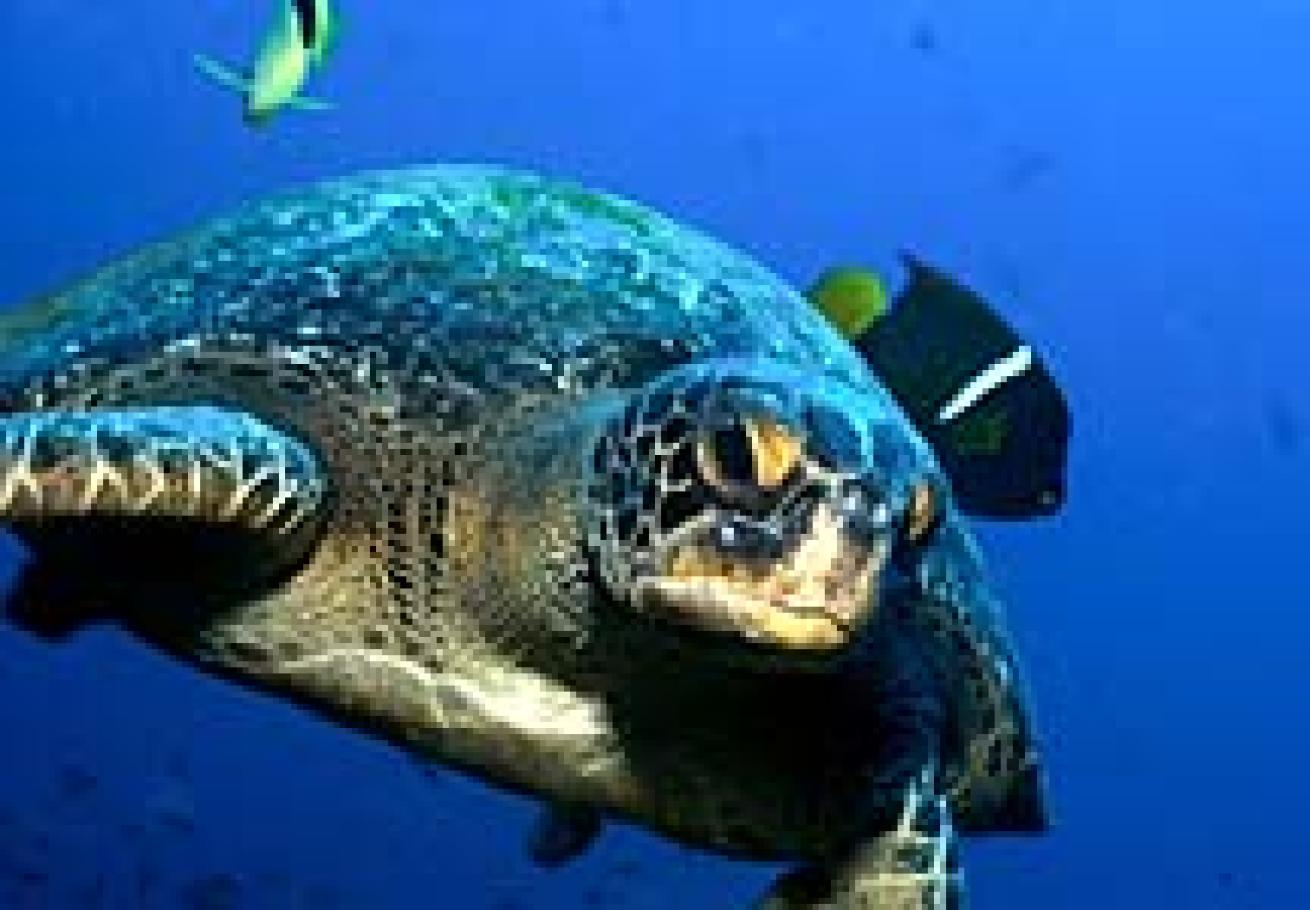
As Alexa said, we anchored in the cove off Bartolome Island and had a nice encounter with the Galapagos penguins in residence there. While we saw them in the water, it was too turbid for quality underwater photos, but those sitting on the rocks were very tolerant of our approach. We shot some telephoto images from the dinghy, but some of the best shots were topside, with our housed digital cameras. We'd creep close to the rocks, wedge ourselves in against the surge, and shoot through our domes with 17-35mm Nikkor zooms. The penguins were totally indifferent to our presence in the water, but we would not be allowed to go on land to get this close. The housed camera made for a versatile tool here.
Finally, to wrap a very busy day, we hiked to the top of Bartolome to shoot the sun setting over the bay. Even though there is a night dive for those so inclined, this is enough for me this day. The 400 steps combined with the day's frenetic pace made me sleep very well this night!
A note on the dive procedures: All diving is done from the 20-foot Zodiac dinghies. Air and nitrox are both available. Divers kit up on the dive deck with everything but their masks and fins. Then they step from the port side of the boat into the dinghy and motor off to the site. The boat rides are short, usually five minutes or less, and if the dive site is too distant from an anchorages the Sky Dancer stays live and in proximity. Very easy, safe and ergonomic indeed. Gratefully the dinghy drivers are very adept at keeping track of the diver's bubbles, and are always there for a quick retrieval.

Day #3
We awake this morning to do a land walk on Rabida Island. Along an unusual reddish sand beach we have our first up-close-and-personal encounters with sea lions. The babies seem especially curious and they go up to the girls and sniff them. The photo opportunities are pretty powerful here, especially once the sun burns through the early morning haze.
We did our first dive of the morning along Rabida, and although visibility wasn't too great, there were naturally plenty of things to shoot. Actually I spent most of my time on a huge school of blackstriped salema in no more than 15 feet of water. I shot up my 512 MB card on the D1X, went into the shade of a coral head and deleted the bad ones, and went back to shoot some more. Very awesome tool.
After lunch we dived a vertical wall face along Albany Island. Once again visibility was poor, maybe only 25 feet, but since we knew that before jumping in, we all chose macro lenses on our digital cameras or film SLRs. I did well with a cooperative king angel, but the highlight of my dive, photographically and inspirationally, was a playful sea lion that briefly posed for my 105mm macro lens. Of course all I could do was shoot a tight head shot with the 105mm, but when those soulful eyes and cute little whiskers popped up in my LCD screen I knew I had a winner.
m

Already I can tell this is going to be a VERY full week. Between land walks like our afternoon visit to James Island (more sea lions and marine iguanas) and multiple dives daily we manage to have time to eat and maybe even relax a little--except for those of us who are shooting digital this week, for the post-dive computer tasks were time-consuming as well. We find we spend a massive amount of time downloading images, captioning, burning to CDs, and generally being tech-heads. Yes, in many ways digital is immediate and very exciting in terms of image capture, but in terms of post-shoot workflow, it is pretty tedious and labor-intensive. Not to mention a little antisocial.
In the days of film we'd be having film processed, looking at pictures together and generally interacting. Now, with digital we're shooting like we always did, except now there is the ability to edit under water and get the immediate feedback from the LCD. So, the percentage of keepers is higher and no one tends to run out of media while under water nearly as much. So, lots of images result. Now those images have to be cleared from the smart cards, put onto the hard drive, edited, ultimately burned to a CD, CD content confirmed, and then the smart card reformatted so we can go shoot again. And then for those so inclined, there is the whole different task of captioning and cataloging the saved images. The processing, captioning, and cataloging would happen with film too of course, but it would happen at home and not on the boat. Now, add to all this the discretionary refinements that can occur after importing to Adobe Photoshop. Cleaning up exposure, eliminating bits of backscatter, and correcting any other color or contrast concerns are additional time-suckers. The first thing you know there aren't enough hours in the day. Yet, such is the price of admission to the new paradigm. I know for the next trip I'll have a faster computer, more RAM, a better screen, and an internal CD or DVD burner. Maybe that, combined with a bit more experience, will make the post-shoot lifestyle more leisurely.
_Dear Journal,
Today we went snorkeling and saw lots of dolphins under water and two sea lions, and one of the sea lions did not have a back fin. The guide, Luis, said maybe a shark bit it off. Before that we went to an island and saw a lot of sea lions. There were two babies and they sniffed me. It tickled. I also saw marine iguanas. Then, this afternoon we saw whales from the boat. Then we went on a walk and saw a lot more sea lions. I got so close! We named a really cute baby sea lion Fussy Wuzzy. Bye journal.
_

Day #4
Dear Journal,
Today we saw whales! We also saw marine iguanas! We saw cool crabs and a lot of sea lion and fur seals. A baby sea lion touched me! Then we went snorkeling and saw two octopuses and a lot of cute sea lions. We also saw a parrotfish and a yellow-backed triggerfish. I also saw three more whales and a tortoise (really a turtle) too! Then we went snorkeling where the divers went and we saw five stingrays in really clear water, a couple of sea lions, a penguin, and a marine iguana. Daddy said he took a picture of a red-lipped batfish and I saw it on his digital camera. I take pictures with my digital camera too!
The morning begins with a land walk at Fernandina Island. This is Marine Iguana Metropolis, with large groups lying one atop the other to keep warm. There are plenty of sea lions as well, all vignettes of a gorgeous land and seascape. After a two-hour land visit, we all went snorkeling in a quiet bay. There were high hopes for finding a marine iguana under water, but we had to settle for shooting a particularly brazen specimen sitting atop a small rock outcropping.
The dives this day are in colder water than we have encountered so far. 68 degrees instead of 76 degrees elsewhere. At Tagus Cove the 105mm becomes the tool of choice due to turbid water conditions. I found a very cooperative octopus, as well as various blennies, hawkfish and other reef minutiae. At Punta Vicente the sand bottom at 100 feet is home to the elusive red-lipped batfish. Once we'd find one they would typically tolerate a couple of shots and then go into flight mode. Either they'd swim away or keep turning their face away from the lens. Very frustrating little fish, but pretty fascinating once captured on media. The challenge here is not to get so obsessed with the batfish that you ignore all the other very cool small creatures along the wall. But since the photo opportunities rise all the way to the surface, this is the perfect multilevel macro dive for either day or night.
_Dear Journal,
We went snorkeling in a place called the Icebox, but it wasn't so cold. I had a wetsuit and booties and gloves so I was warm. We saw sea lions and they went under the boat. We saw turtles, stingrays, and lots of fish. In fact, I saw six stingrays and I don't even know how many turtles, but I think I saw nine. We saw penguins, blue-footed boobies, and more. Bye Journal. Oh yeah ... we snorkeled into a cave too!
_
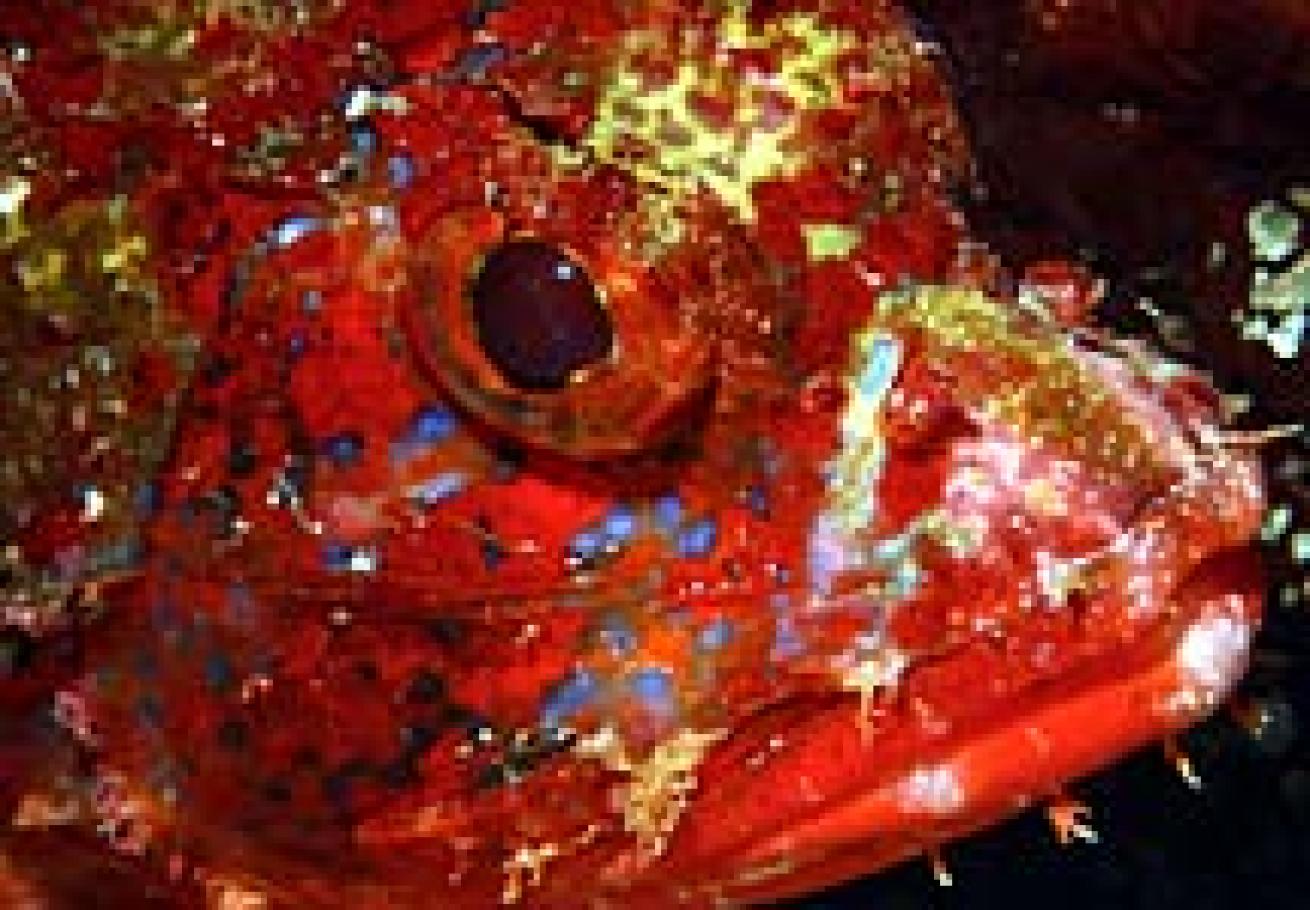
Day #5
From Punta Vicente to the Northern Islands is only about an eight-hour crossing, and the calm seas and stability of Sky Dancer made it a pleasure. Actually I've been very impressed with this vessel all week. The crew is outstanding, the food is fine, the general dive safety procedures top-notch, and the dinghy drivers in particular are very attentive. The cabins are comfortable and the air fills right on every time. Perhaps the greatest compliment is that this trip is without aggravation. Thanks Peter. Thanks Ecoventura.
The northern islands, Wolf and Darwin, are the adventure dive mecca of the Galapagos. Possible encounters with whale sharks, schooling hammerheads, dolphins, Galapagos sharks, turtles, tuna, and so much more motivated us all to switch to wide-angle lenses. The visibility improved to about 80 feet up north, and the water oddly warmed as we moved farther from the equator. Of course this is a function of currents rather than latitude, but still, warm is warm.
On our first dive at Wolf we jumped in at a spot called Shark Bay, although this day it wasn't particularly sharky. There were moray eels scattered all along the bottom, and they willingly posed. I also shot guinea fowl pufferfish, several hawksbill turtles, yellowtailed surgeonfish, and bunches of barberfish seemingly grazing on triggerfish eggs. It was actually a great dive, but I only saw a couple of hammerheads and none came particularly close. Still, there was plenty to shoot and I recorded significant images to my card.
Our second dive was to another Wolf dive site known as Landslide. Here we did see Galapagos sharks and some hammerheads, but all fairly distant. The closest I got to any shark was maybe eight feet. Turtles yes. Sharks ... not really. However, I did get into an absolutely massive school of bonito near the surface. They raced all around me in such power and numbers I was once again reminded of how rich and deserving of protection these waters remain.
_Dear Journal,
Today we went snorkeling and saw lots of fish, sea turtles, dolphins and hammerhead sharks. We saw a kind of ray called a mobula ray. They were so cool. They were so close and very pretty. The water was so clear. It was beautiful! We saw frigate birds. They should be called big red balloon birds for the red thing on their necks. We saw baby dolphins too. Bye Journal.
_
Following our two morning dives at Wolf we steamed another couple of hours to Darwin Island. Normally the Sky Dancer spends two days of a one-week itinerary, but we asked for a custom cruise to optimize both land walks in the Central Islands and the diving in the north. There are no land walks possible at Wolf or Darwin, and I have found the terrestrial appeal of these islands to be nearly as compelling as the underwater.
Unfortunately, this day Darwin did not live up to its potential. Even though the seas were calm, and the water pleasantly warm and clear, the current was not running. Seemingly without current the hammerheads don't come close to the submerged rocks off Darwin's Arch. So, instead I shot a turtle and miscellaneous reef fish, but was unimpressed with the pelagic action this day. Apparently the rest of the guests felt the same, for by consensus we decided to head back to Wolf. Yeah ... I know. This can be one of the world's great dive sites, but for us this week it wasn't happening.
Darwin can be absolutely awesome, but it depends on season and currents. From June through December the water is cooler and rougher, and the skies more often overcast. But it also means hammerheads and whale sharks are far more prevalent at Darwin. Groups have seen as many as eight different whale sharks and hundreds of hammerheads on a single dive here,. But we purposely booked for February to assure calm seas and ample sunshine, but we didn't really have currents at either Wolf or Darwin. Probably due to the phase of the moon, which is yet something else to consider. Still, the Northern Islands in the fall sounds pretty exciting, and maybe next time we charter Sky Dancer will be for that season and those critters.
_Dear Journal,
We went snorkeling again. We saw hammerheads, silky sharks and an eel. The place we went was called Darwin. On the dinghy we saw dolphins. Bye Journal.
_

Day #6
Actually it was good to have a night without diving and a chance to offgas. While nothing is real deep here, it is certainly possible to spend lots of time in the 60- to 80-foot range and the body will definitely saturate. I dive nitrox on air tables whenever possible to build in some safety margin, but even my body told me it was on nitrogen overload and to back off a little. I truly appreciated the consistently high quality nitrox fills we got onboard. It helped me through the week for sure. (Note -- nitrox aboard costs $100 for the week, or can be purchased for $10 surcharge per tank).
The first dive this morning was to The Pinnacle at Wolf Island. I've dived this site when the current was raging, and it can get a little hairy, but today the current was extremely mild. As soon as we dropped in we saw a marbled ray, and my wife Barbara moved in as an element of composition in my wide-angle shot. We also found a small cave to work diver silhouettes, and a cooperative eel to pose in the foreground. For us it was a very productive dive, but we never did make it all the way to the pinnacle. Those who did saw more schooling fish but no shark aggregates. The clock is ticking and I still don't have my hammerhead shot! Actually, we saw more sharks at Landslide than anywhere else so far, so that seemed the logical place to try again.
Between dives we went snorkeling with the kids. For me it was fun to hang out with the kids and watch them enjoy the sea. But, as my daughter was eager to point out, the best stuff happened after I went back to the mother ship to go diving.
Dear Journal,
Today we saw dolphins, hammerheads, fish and I saw a huge trumpetfish. There were baby dolphins too. The dolphins got REALLY CLOSE!!
On this final dive at Wolf I decided to quit being distracted by all the small animals and concentrate on hammerheads. But, after a few fly-bys and nothing really good enough to shoot, I did in fact find a cooperative green sea turtle and a few barracuda. There were thousands of spawning wrasse as well, and in fact the whole seafloor was alive with some small creature or another. But, still my target species, the scalloped hammerhead, remained elusive. So, with 500 psi in my tank and about three minutes before going into deco at 94 feet, I figured I'd wrap a few more frames on the barracuda. Luckily I drifted into some pretty hot hammerhead action at the last possible moment. One bold shark swam into view and I got three progressively closer shots with the D1X and 60mm lens with dome port. Seeing those images pop up on the LCD was a great satisfaction, and a relief knowing that I wouldn't get skunked by hammerheads this trip!
Now, 20 hours to steam back to the Central Islands, for our final dives tomorrow and a visit to the Charles Darwin Research Station.
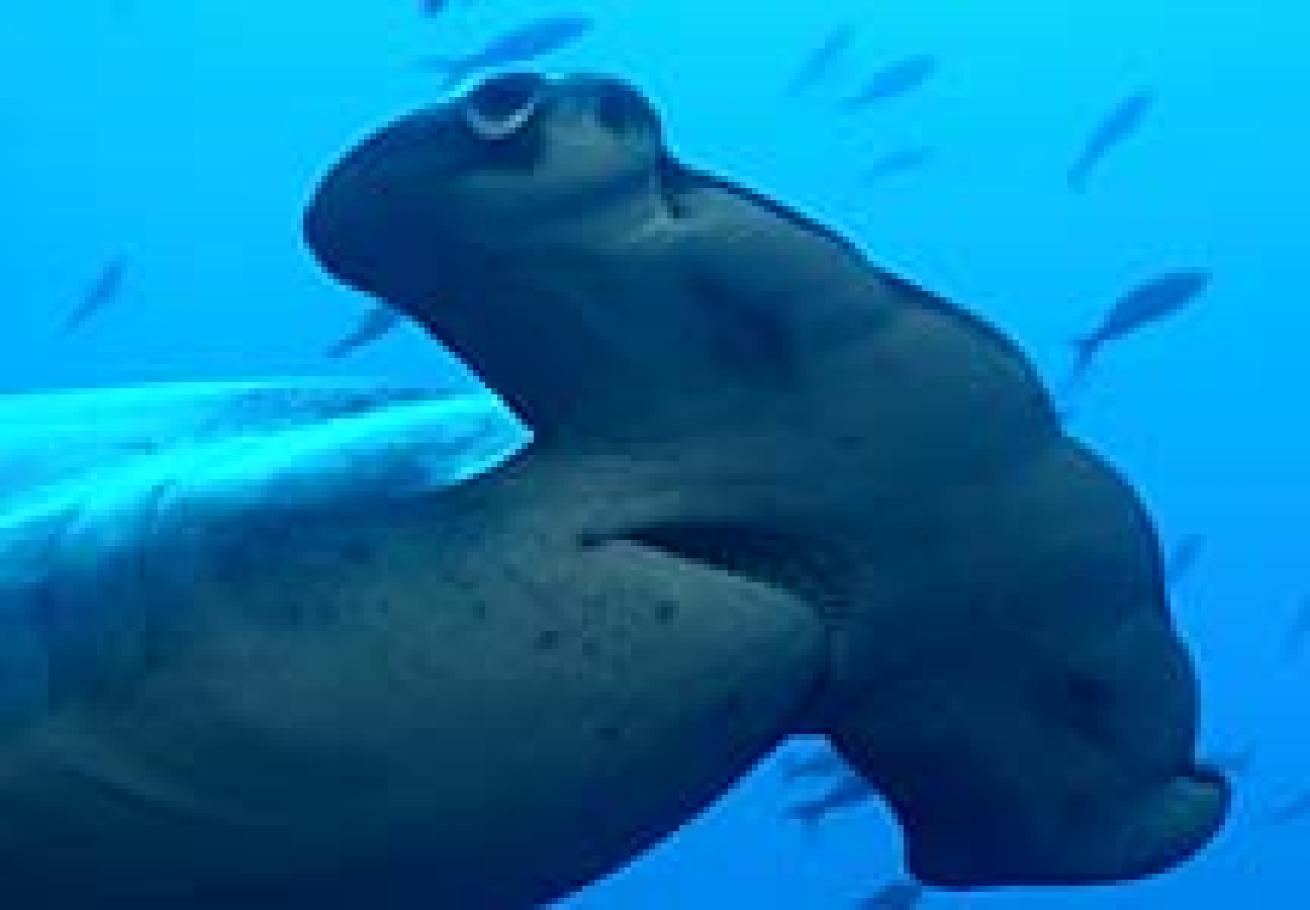
Day #7
On this day we chose to dive Gordon Rocks, a place where I have had extremely productive dives in the past. Not so today really. The visibility was on the green/turbid side, but we did see four sea turtles the minute we dropped in the water. Then I worked a few eagle rays swimming in formation. And then when I took my eyes from the viewfinder, I saw I was amid the hammerheads. Of course, when they knew I knew they were there, they bolted. So, I was seeing some things, but not really capturing them on film/pixels. The current started to pick up too, and I began to have trouble moving against it. But I did see a huge aggregate of king angels feeding, something I had seen at Gordon Rocks before but never captured to my satisfaction. These fish absorb light, and to use a strong enough strobe and wide enough aperture to expose the fish sometimes makes the backgrounds too light. The immediate feedback from the LCD on the D1X made it possible for me to dial in the exposure, and then move in tight for the critical images.
Dear Journal,
Today is the last day. I am going to miss the Galapagos and Luis, our guide. He is really nice. The trip was really fun. The live-aboard boat was nice. And I will miss my friends Hanna and Alexa. Some of my favorites things were the baby dolphins, the sharks, the turtles, the sea lions, and the frigate birds. I liked the party that the crew had for us too. We all danced and had fun. Bye Journal.
Our final dive of this trip was to Plaza, actually more of a snorkel with the sea lions. Here it is very easy to get close, and you need to because the water isn't very clear. But, to remove myself from the photo challenges for a moment and just enjoy the moment, this was a very cool interlude. The mother sea lions got very close, and occasionally the big bull would swim through with a little bark to assert his authority. Our kids were really excited about this chance to swim with the sea lions, for while they had fleeting underwater encounters previously, they had never been really among them. With this wonderful memory, this year's dive experience in the Galapagos concludes.
The final afternoon we visit the Charles Darwin Research Station on Santa Cruz Island, which is kind of interesting the first time, but with multiple visits becomes a bit boring. It always struck me as "And now, a word from our sponsor". If you come to the Galapagos your tour company is obligated to take you to the Darwin Station. And since everyone must stop here at some point during the week, the city of Puerto Ayora has developed with T-shirt and curio shops to cater to the tourists. I must say however that most of the souvenirs are fairly tasteful. T-shirt vendors in Key West would certainly have a more crass way of exploiting the blue boobies.
As we stood on the dock on the last morning waiting for the bus to the airport I asked my wife to rate this trip. From the view of the quality of the services aboard the boat and the absolute friendliness of the crew, a 10. As far as the combination topside and underwater attractions of the Galapagos, a 10. From a child's perspective in terms of learning appreciation for nature, a 10 if not higher. As far as comparing this year's Galapagos encounters with those we've known in the past, very difficult to rate. The Galapagos experience will always depend on the currents, the time of year, moon phase, and luck. I've certainly seen more hammerheads, Galapagos sharks, and more schools of jack and tuna than I saw this time. But then I know that those who dive these islands when the waters are cooler have had multiple close encounters with all of the above. It is an ecosystem in constant motion, and when the currents and cold-water upwelling are there to bring nutrients to the surface, the diving is like nowhere else on earth. And for that which is there, it takes luck and skill to capture it photographically. Luck to be there, luck to see it, and the skill to freeze that very special moment in time.
MV Sky Dancer
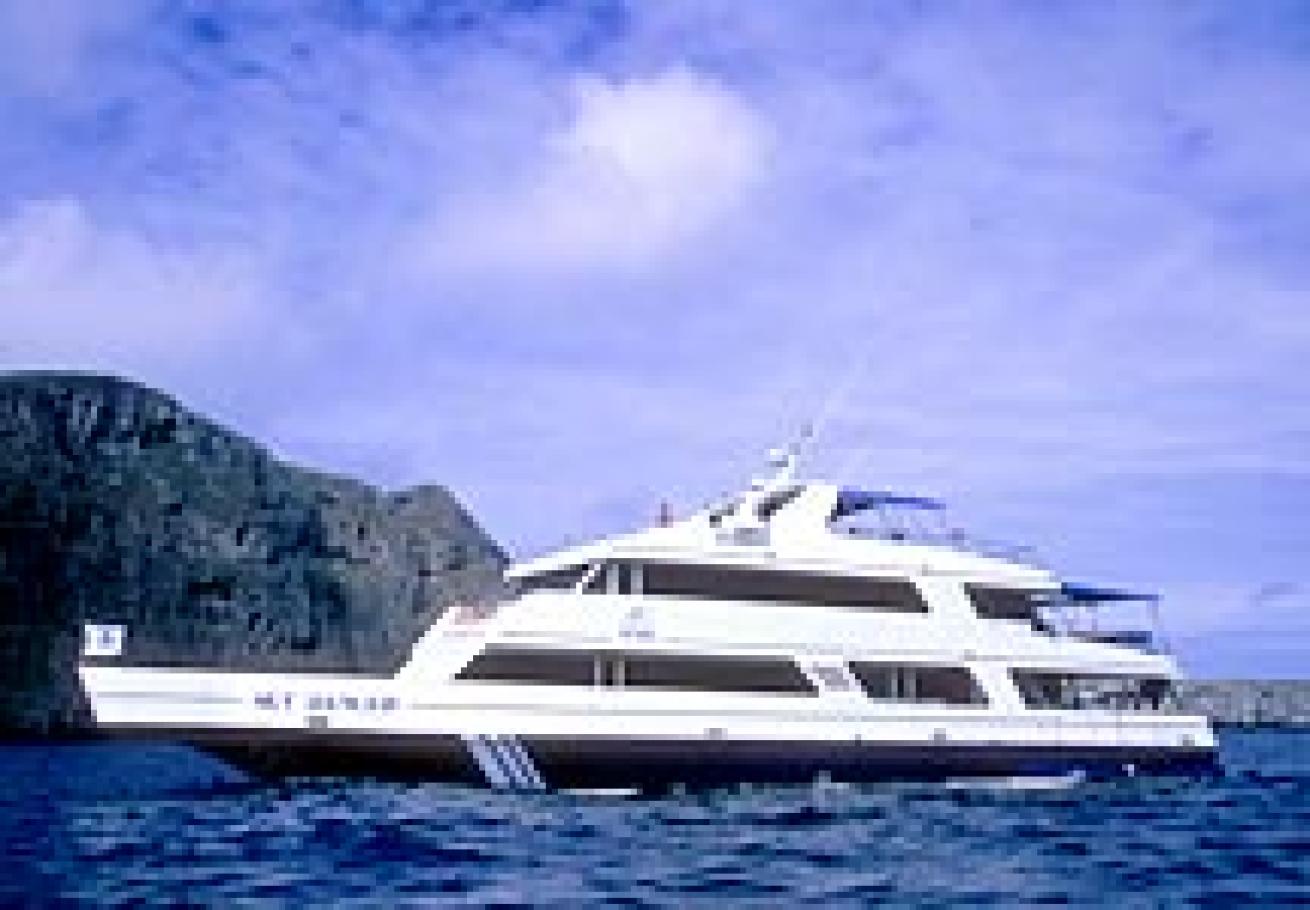
The MV Sky Dancer specs are as follows:
Port of Registry: Ecuador
Built: Ecuador 2000
Construction: Steel
Type: Mono Hull
Length: 100 feet
Beam: 24 feet
Max. Passengers: 16
Staterooms: 8
Number of Crew: 8 seamen plus 2 National Park guides and 1 student guide
Number of Tenders: 1
Fuel Capacity: 8000 gallons
Freshwater Capacity: 6000 gallons
Desalination Production: 1500 gallons per day
Cruising Speed: 12 knots
Range: 2400 nautical miles
Navigation Aids: VHF, GMDSS, SSB, color radar, echo sounder, GPS, weather fax.
Compressor: (2) K-14 Bauer
Voltage: 110 volts and 220 volts
Air-conditioning: Yes
Length of Charters: 7- and 10-night itineraries
Dives Per Day: Up to 5
Photographic Services: E-6 processing, camera rental, photo instruction, video rental, video instruction.
Cabin amenities as follows:
LIDO DECK Master Staterooms (1,2,3,4)
One queen bed or two twin beds, private facilities, window view, mirrored cabinet, wardrobe, bathrobes, hair dryer, toiletries, fresh towels daily, independent air-conditioning and volume controls
DOLPHIN DECK Twin Staterooms (5,6,7,8)
Two twin beds, private facilities, portlight view, mirrored cabinet, wardrobe, bathrobes, hair dryer, toiletries, fresh towels daily, independent air-conditioning and volume controls
Dive Tenders
The M/V Sky Dancer features two MK V Zodiac brand inflatable dive tenders of 6.5 meters in length (21.5 feet) and 2.5 meters in width with 40 hp 4-stroke engines for maximum efficiency and a smooth, quiet, low exhaust ride.
Each tender accommodates up to eight guests on each, plus a driver. Each tender will also carry two divemasters on board: One is a naturalist guide (and a qualified divemaster) and the other is a dive professional approved by the National Park. One guide will assist with shooting video or photos. On land tours a guide will even carry a sun reflector to assist guests with taking well-lit photos of land fauna without the use of a strobe (which is prohibited by the Marine Park).
Dive Sites
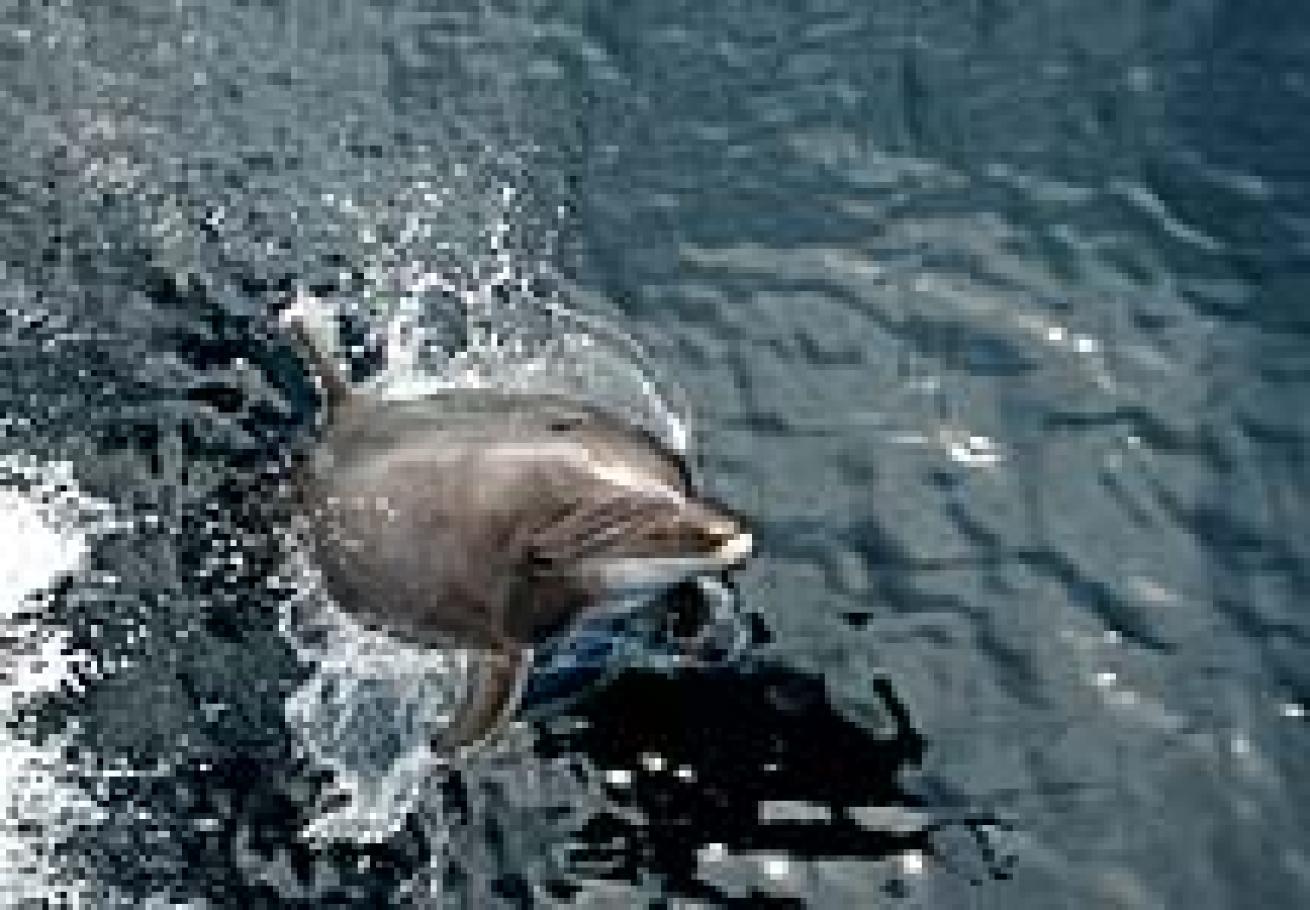
The following is directly verbatim from Fernando Ortiz, one of the most experienced dive guides in the Galapagos Islands:
Isla Lobos
20 ft of water, scores of friendly sea lions come to join the divers. It is good for garden eels, some tropical fish and stingrays. Sea turtles and eagle rays are found frequently. A couple of times, we have seen marine iguanas grazing under water.
Currents: none, sometimes, water motion associated to tides.
Water temp: Dec. - April: 74 - 78 / May - Nov: 68 - 72 degrees Fahrenheit
Thermoclines: none
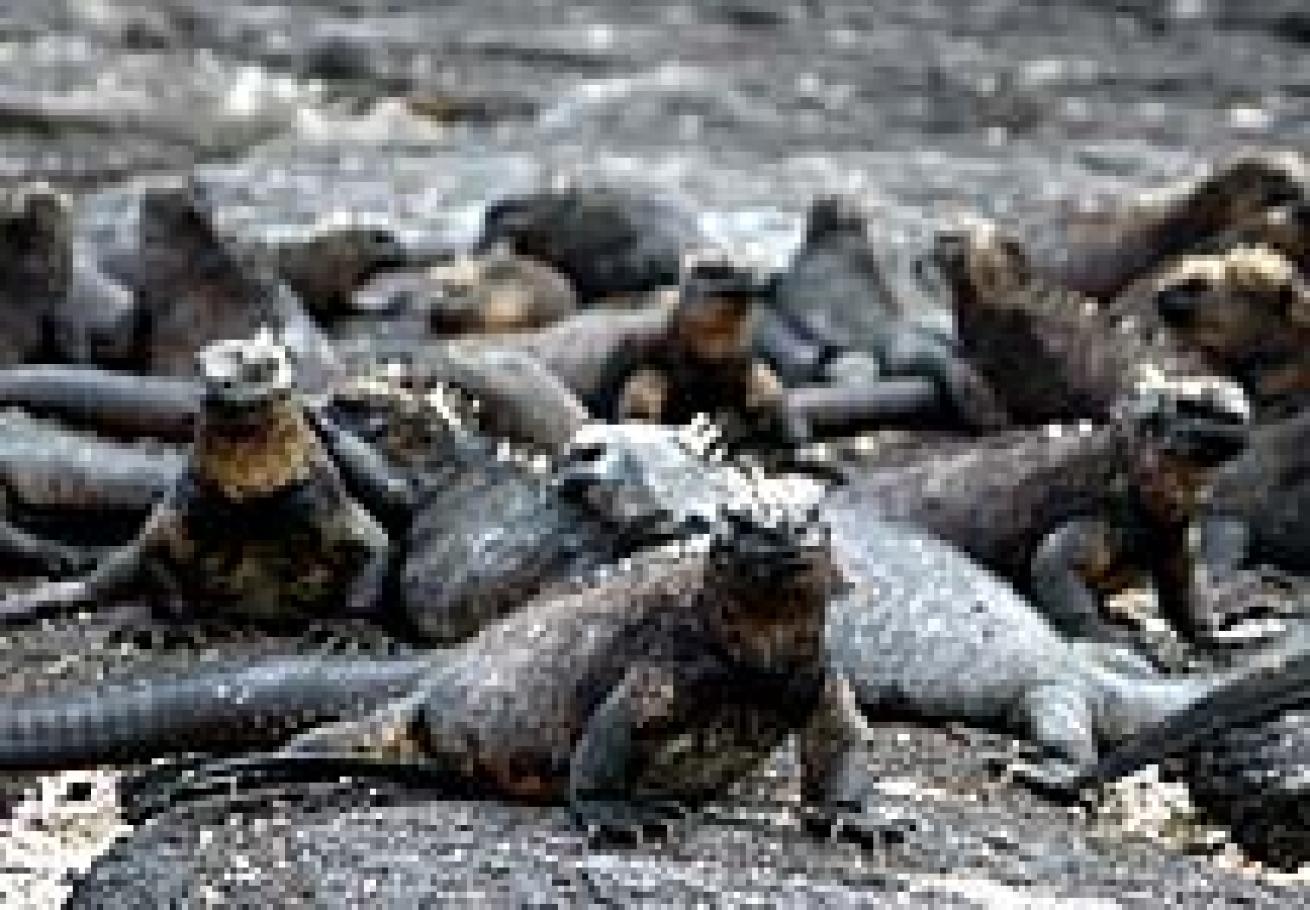
North Seymour
Great dive site. Good for all sorts of rays year-round and especially good for mantas from December until April. Lots of whitetip reef sharks rest on the sandy spots. Good place for sea lions, sea turtles and hammerhead sharks. Several thick schools of grunts and snappers live associated to the reef.
Currents: prevalently from south. It goes from moderate to very strong.
Water temp: Dec. - April: 74 - 78 / May - Nov: 68 - 72 degrees Fahrenheit
Thermoclines: at 45 ft and sometimes also at 75 ft.
Cousins Rock
A dive site with a bit of everything for every taste. You can find whitetip reef sharks, hammerhead sharks, sea lions hunting, fur seals and many sleeping sea turtles. A highlight is a resident school of up to 30 spotted eagle rays. If you are interested in macro photography, look for seahorses, frogfish, lobster, arrow crabs, cup coral, blue crabs, longnose hawkfish, coral hawkfish, nudibranchs, etc. It is superb for night or day diving.
Currents: prevalently from northeast. It goes from moderate to strong. Occasionally very strong, coming from the north.
Water temp: Dec. - April: 74 --78 / May -- Nov: 65 -- 72 degrees Fahrenheit
Thermoclines: variable from 65 to 90 ft
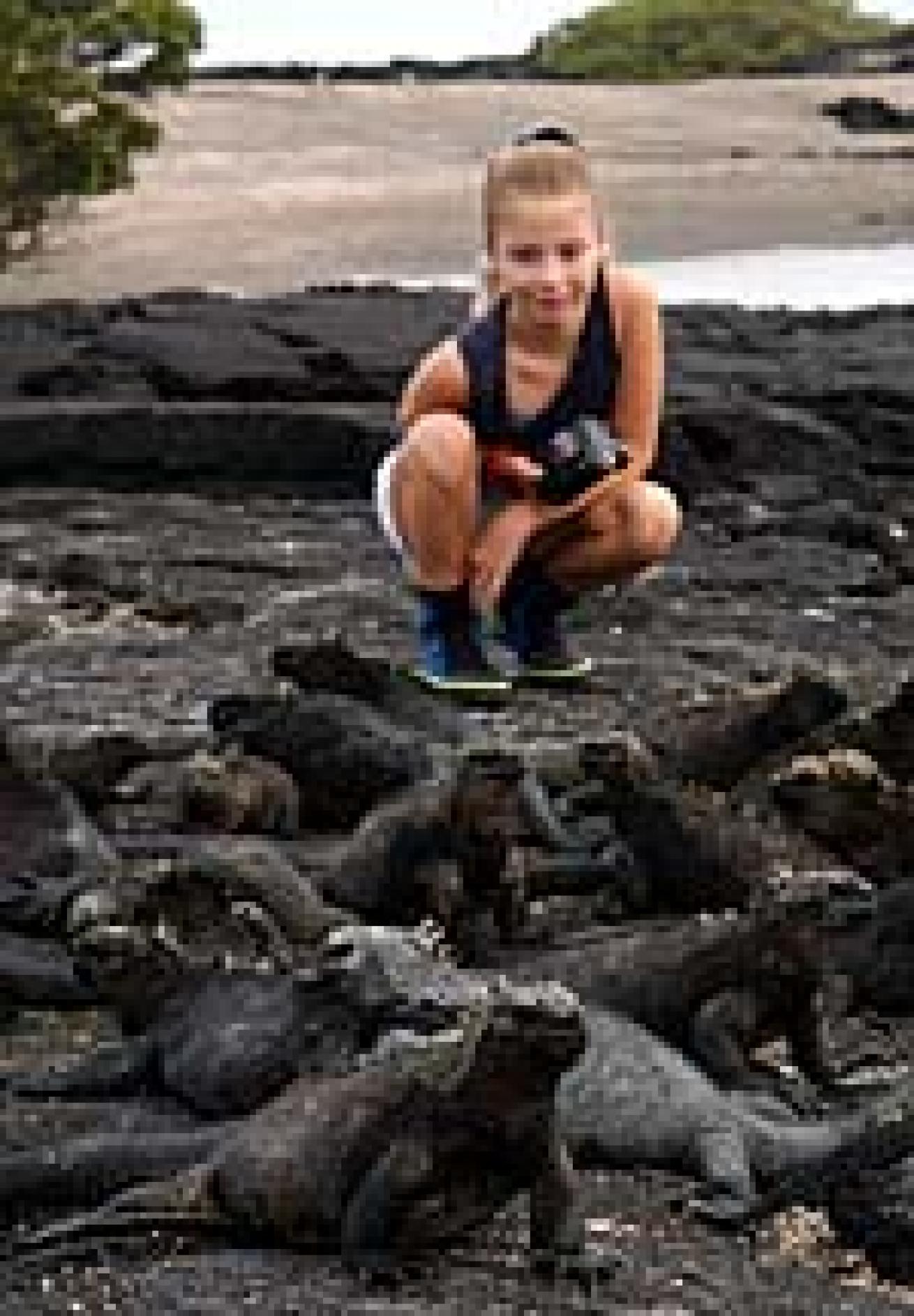
Tagus Cove
Cold-water dive (sometimes as low as 62F.). It is excellent for sea turtles and macro subjects such as red-lipped batfish, and the endemic "camotillo," a species of fish restricted only to Galapagos waters. While making your safety stop, keep an eye out for penguins or flightless cormorants coming your way. On the deep sandy bottom you can find sawfish and devil rays.
Currents: none.
Water temp: Dec. - April: 70 - 76 / May - Nov: 62 - 72 degrees Fahrenheit
Thermoclines: variable, but normally below 65 ft
Punta Vicente Roca
One of the very best macro dives in Galapagos. It can be cold (as low as 62F). The list of invertebrates that is found on this wall dive is endless, from the simplest sponge to really beautiful flatworms. Besides you can find seahorses, frogfish, port Jackson sharks, red-lipped batfish, and the endemic "camotillo". At the beginning of the dive keep your eyes open for "mola mola" or moon fish.
Currents: none
Water temp: Dec. - April: 70 - 76 / May - Nov: 62 - 72 degrees Fahrenheit
Thermoclines: variable, but normally below 65 ft

Wolf Island
One of those magical islands, with several dive sites to choose from. If you want to see sharks, you are at the right spot. This is a place for schooling hammerhead sharks, large aggregations of Galapagos sharks and occasionally whale sharks. Seeing dolphins, large schools of tuna, spotted eagle rays, barracudas, sea lions and sea turtles is common. The bottom is littered with hundreds of moray eels, many of them free-swimming. Being several degrees warmer than the Central Islands, you can look for many representatives of Indopacific underwater fauna.
Currents: Normally from southeast, but variable. It goes from moderate to very strong. Eddies and down drafts associated to some dive sites. The south side of the island features strong surge that is potentially dangerous if divers don't surface out in deep waters. Trust your guide and do as he recommends.
Water temp: Dec. - April: 76--82 / May -- Nov: 74 -- 76 degrees Fahrenheit
Thermoclines: at around 65 ft, but highly variable
Darwin Island
Considered by many experienced divers as the best dive site in the world, The Arch at Darwin island honors its reputation. It is warmer by a few degrees than the Central Islands. In a single dive you can find schooling hammerhead sharks, Galapagos sharks, large pods of dolphins, thick schools of skipjack and yellowfin tuna, big eye jacks, mobula rays and silky sharks. From June to November, we can almost guarantee whale sharks in numbers of up to eight different individuals in one single dive. The presence of occasional tiger sharks, black and blue marlin and killer whales, complements this amazing diving experience. If you still have time to look for smaller stuff, you'll find octopus, flounders and an enormous variety and abundance of tropical fish. Darwin Island is the biggest jewel on the Galapagos Crown.
Currents: Normally from southeast, but variable. It goes from moderate to very strong. Current splits right in front of The Arch. Drifting south-southeast is potentially dangerous due to shallow reefs and the difficulty to cover that area for search. Trust your guide and do as he recommends.
Water temp: Dec. - April: 76 - 82 / May - Nov: 72 - 78 degrees Fahrenheit
Thermoclines: at around 65 ft but variable.
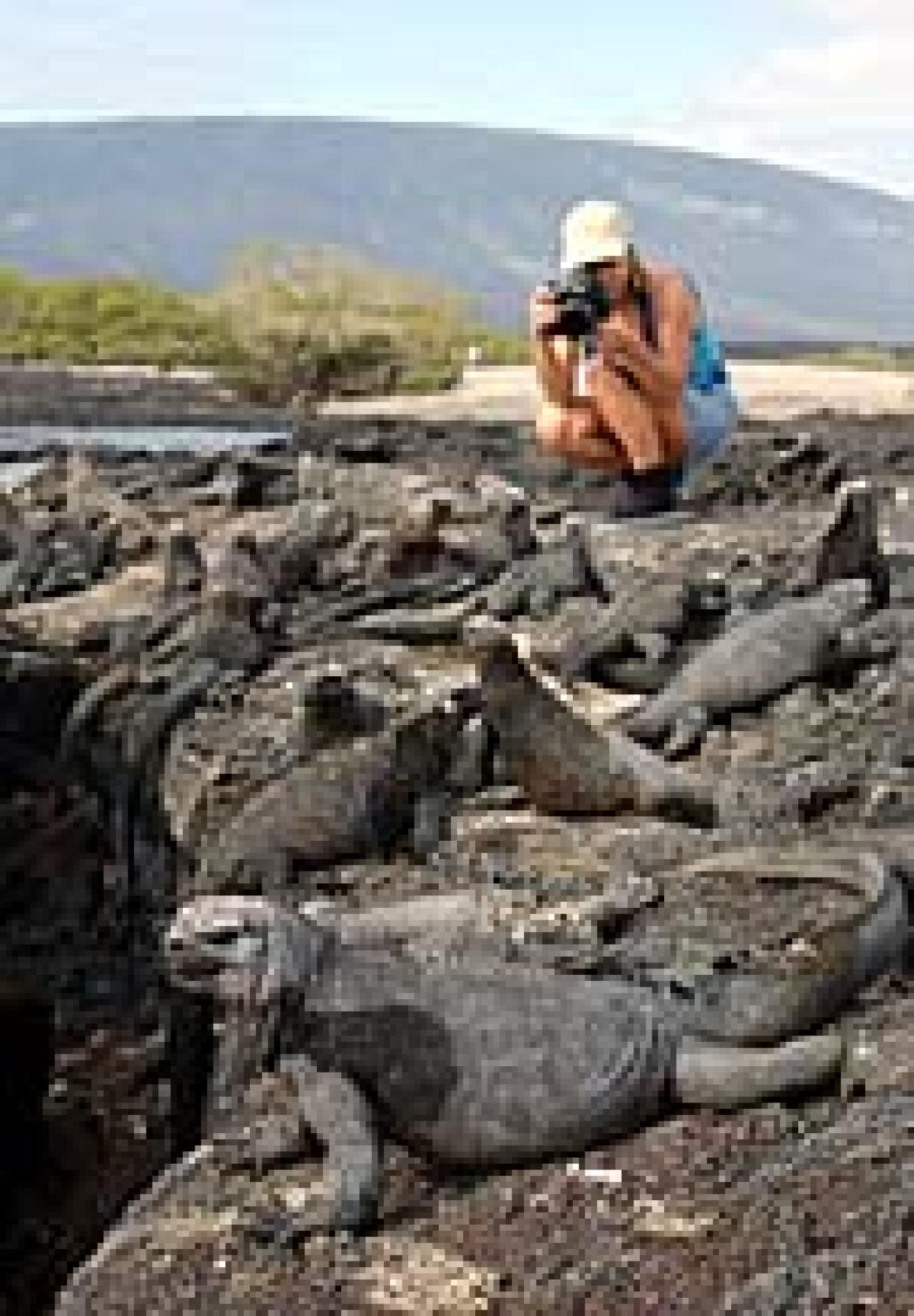
The Northern Channel
On the south side of Seymour Island and no deeper than 50 feet deep, the northern channel is superb. It features an enormous "field" of garden eels, stingrays, a school of spotted eagle rays, whitetip reef sharks and thick schools of grunts, snappers and goatfish. When Dr. Sylvia Earle described Galapagos as "the fishiest place in the world", she had probably dived this site.
Currents: from east. It goes from moderate to strong. When surfacing, water accelerates on top of the shallow part of the reef causing quick drifts. Make your safety stop holding to a rock.
Water temp: Dec. - April: 74 - 78 / May - Nov: 68 - 72 degrees Fahrenheit
Thermoclines: at about 45 ft.
North Plaza
In our normal itineraries, this dive site is the best way of ending your trip on board Sky Dancer. Its shallow waters are home to a rookery of playful young sea lions.
Currents: none, sometimes, water motion associated with tides.
Water temp: Dec. - April: 74 - 78 / May - Nov: 68 - 72 degrees Fahrenheit
Thermoclines: none
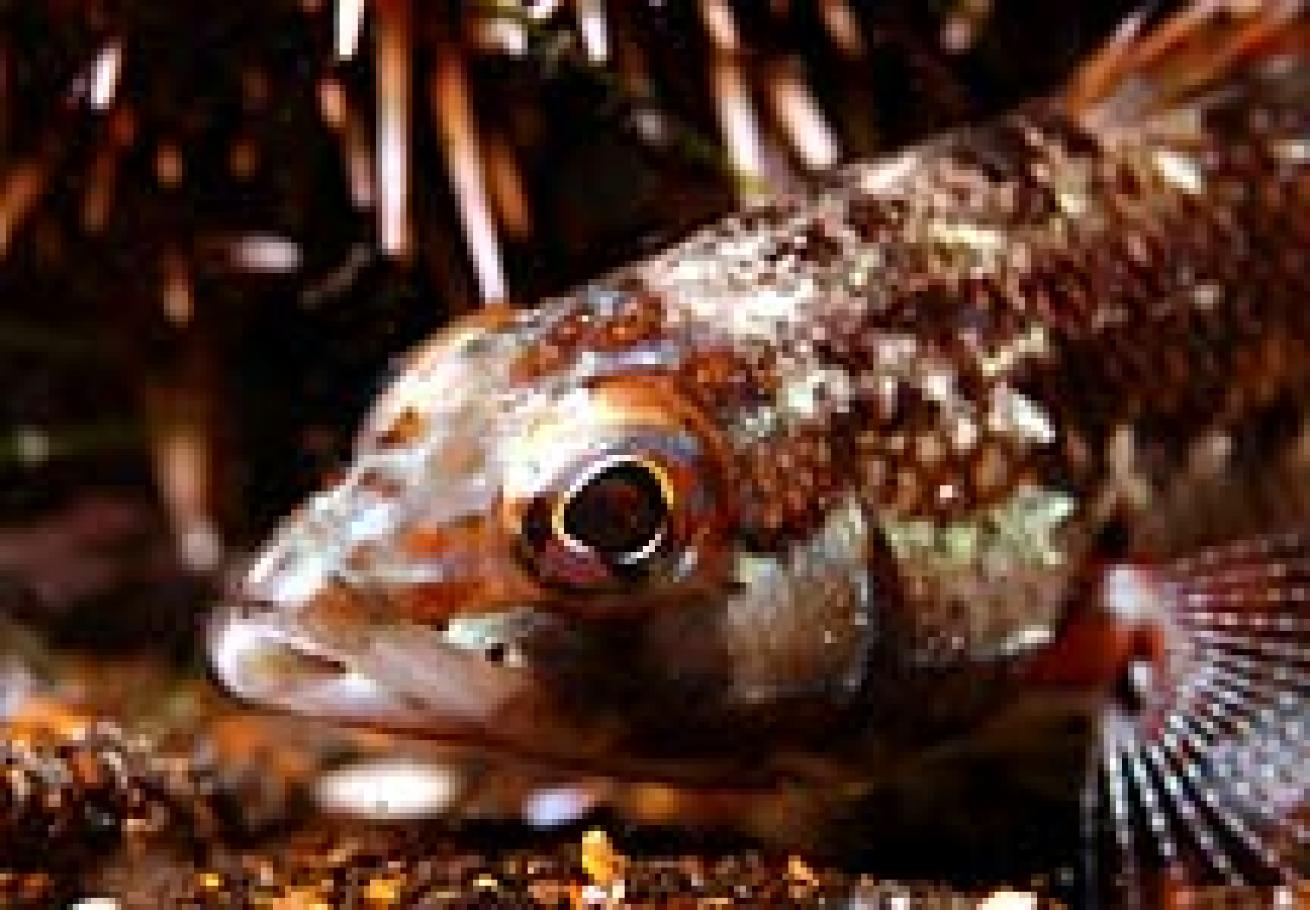
Gardner's Seamount
This place features the greatest biodiversity in the archipelago. During a dive here, you can see anything from the smallest barnacle blenny to whale sharks. Common inhabitants of this seamount are large schools of yellow and dog snappers, Mexican goatfish, moray eels, stingrays, spotted eagle rays, whitetip reef sharks, Pacific burrfish, guineafowl puffers, bullseye puffers, box fishes, king angelfish, three banded butterflyfish, barber fish and three species of grunts. If you venture to the sandy bottom, you may find red-lipped batfish.
Currents: normally from southeast. Variable, but mostly moderate.
Water temp: Dec. - April: 74 - 78 / May - Nov: 68 - 72 degrees Fahrenheit
Thermoclines: at around 45 ft.
Enderby Island
A great dive site. If you stay above 50 ft, you can see thick schools of king angelfish; yellow tailed surgeonfish, puffers, grunts, snappers and groupers. It is also a good place for hammerheads and Galapagos sharks. At the end of the dive, on the wall, you can find seahorses clinging to the branches of the black coral.
Currents: normally from southeast. Variable, but mostly moderate.
Water temp: Dec. - April: 74 - 78 / May - Nov: 68 - 72 degrees Fahrenheit
Thermoclines: at around 45 ft.
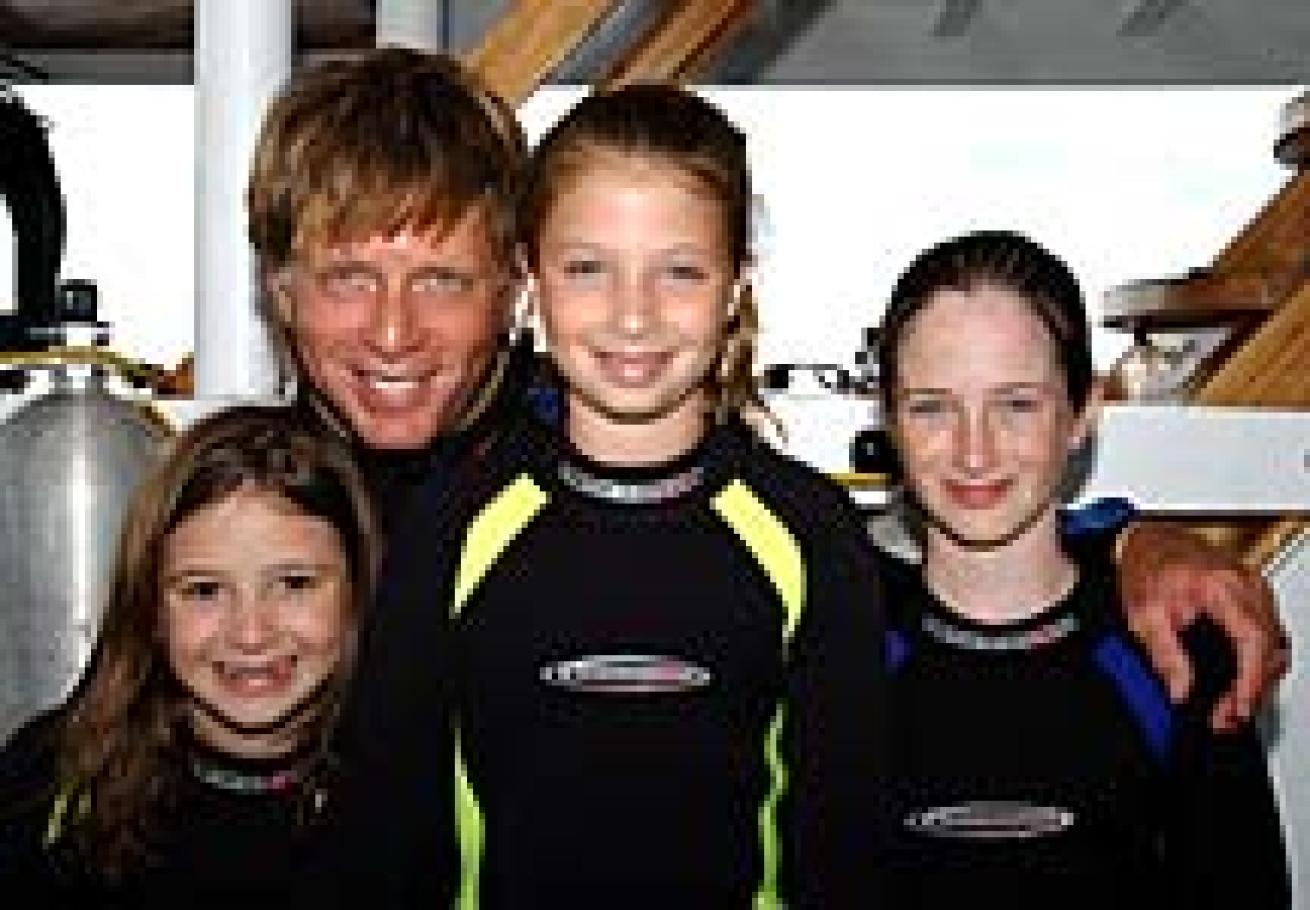
Champion Island
One of the nicest real drift wall dives in Galapagos. You can easily glide alongside the island escorted by a group of friendly sea lions. You can also look around for sharks, rays and sea turtles. If you are interested in small creatures, look for seahorses, longnose hawkfish and coral hawkfish.
Currents: normally from southeast. Variable, but mostly moderate.
Water temp: Dec. - April: 74 - 78 / May - Nov: 68 - 72 degrees Fahrenheit
Thermoclines: at around 45 ft.
Devils Crown
A shallow dive site that features thick schools of all kinds of tropical fish. Groupers, snappers, grunts, creolefish, rays, sharks, morays, jacks, sea lions and turtles mingle together in a chaotic frenzy of sea life. Hold on to a rock and enjoy the show.
Currents: normally from southeast. Variable from moderate to very strong.
Water temp: Dec. - April: 74 - 78 / May - Nov: 68 - 72 degrees Fahrenheit
Thermoclines: none
Other Dive Sites
Roca Redonda
The word unpredictable may have been specifically created to describe this dive site. It is the peak of an enormous underwater mountain. It is famous for its Galapagos sharks, schooling hammerheads, and large schools of barracudas and underwater fumaroles. It is also famous for its overpowering down draft and surge, and its dramatic and sudden fog. It is not a place for beginners.
Currents: Variable in both direction and strength. Very strong surge. Unpredictable downcurrent.
Water temp: Dec. - April: 74 - 78 / May - Nov: 68 - 72 degrees Fahrenheit
Thermoclines: normally below 45 ft.
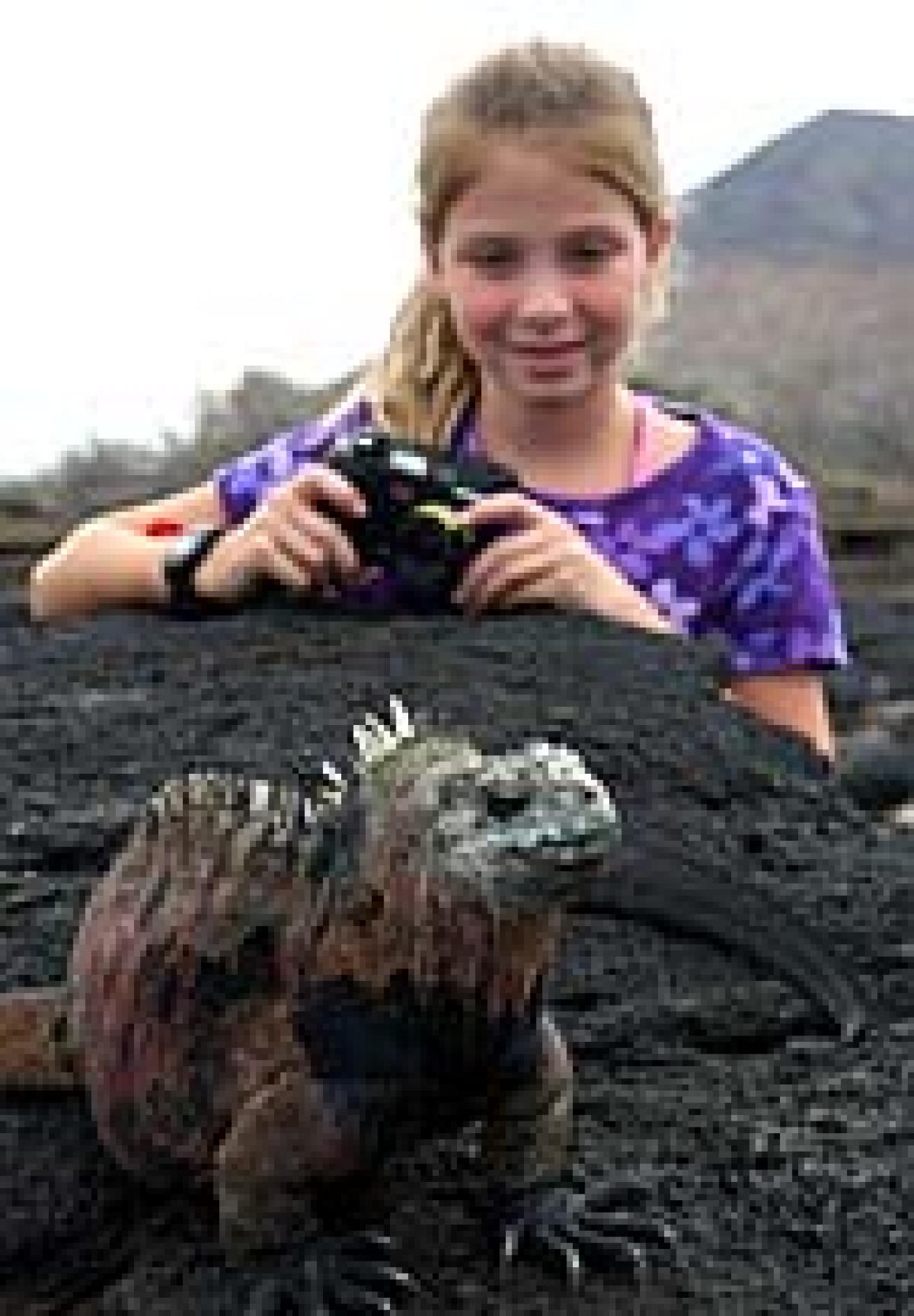
Gordon's Rocks
An exciting dive. Manta rays, spotted eagle rays, Galapagos sharks and hammerheads are common sightings. Its unique underwater topography allows forever changing conditions in terms of currents and surge. You can find sea turtles and seasonally, a large school of up to 50 cownose or golden eagle rays.
Currents: from southeast. Variable from moderate to very strong. Due to the peculiar underwater topography, there is the presence of eddies and downcurrents. Surge can be magnified inside the caldera of this very eroded underwater crater.
Water temp: Dec. - April: 74 - 78 / May - Nov: 68 - 72 degrees Fahrenheit
Thermoclines: normally below 65 ft.
Cabo Marshall
A good dive site. Hammerheads and mantas are a common sight. Chevron barracuda, snappers, groupers and occasionally thick schools of the endemic brown-striped salema are part of the resident underwater fauna. The infrequent presence of oceanic white tipped sharks, blue and black marlin make this a dive with lots of potential surprises.
Currents: normally from the southeast. Variable from moderate to very strong.
Water temp: Dec. - April: 74 - 78 / May - Nov: 68 - 72 degrees Fahrenheit
Thermoclines: normally below 45 ft.

